
WESTERN ® Celebrating Western Equestrian Lifestyle EQUESTRIAN Fall 2023 www.EliteEquestrianMagazine.com Canyon Madness Ranch Experience of a Lifetime Ty Murray Exclusive Interview Jessie Bonneau Tyrel Johnson Audra Tyson Hanna Somatics® Inspiring Equestrian Sculptor Barrel Racer Great For Horses
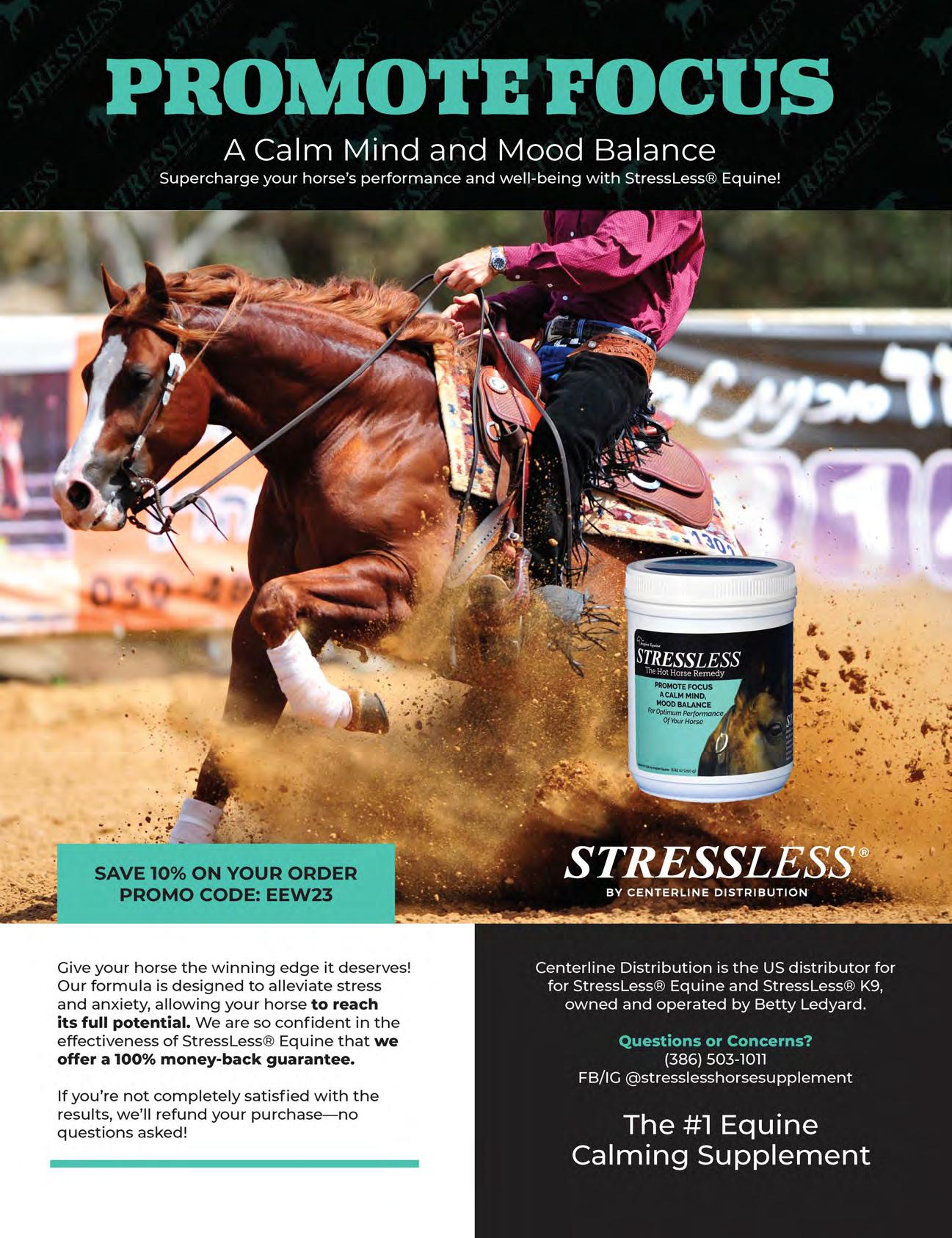
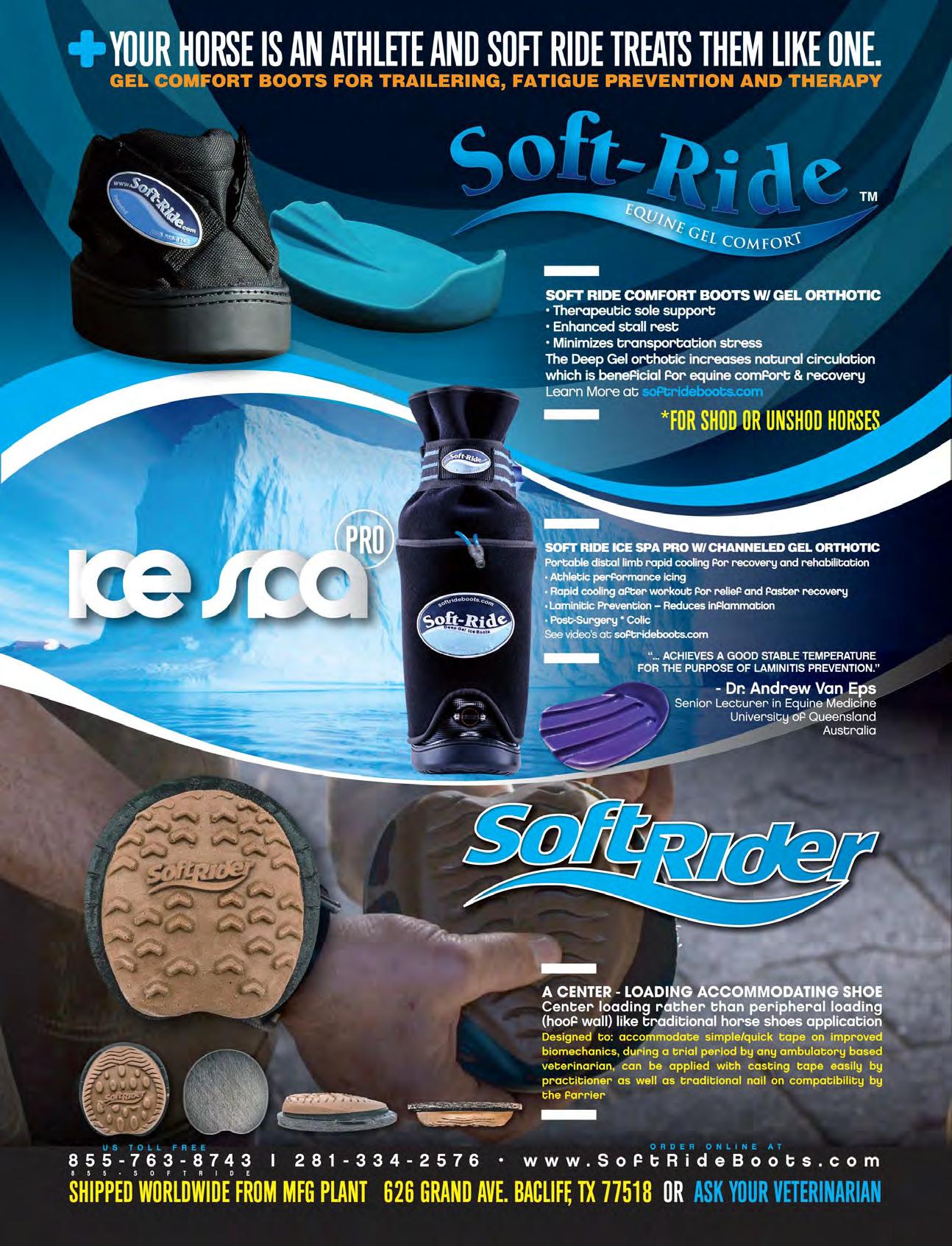
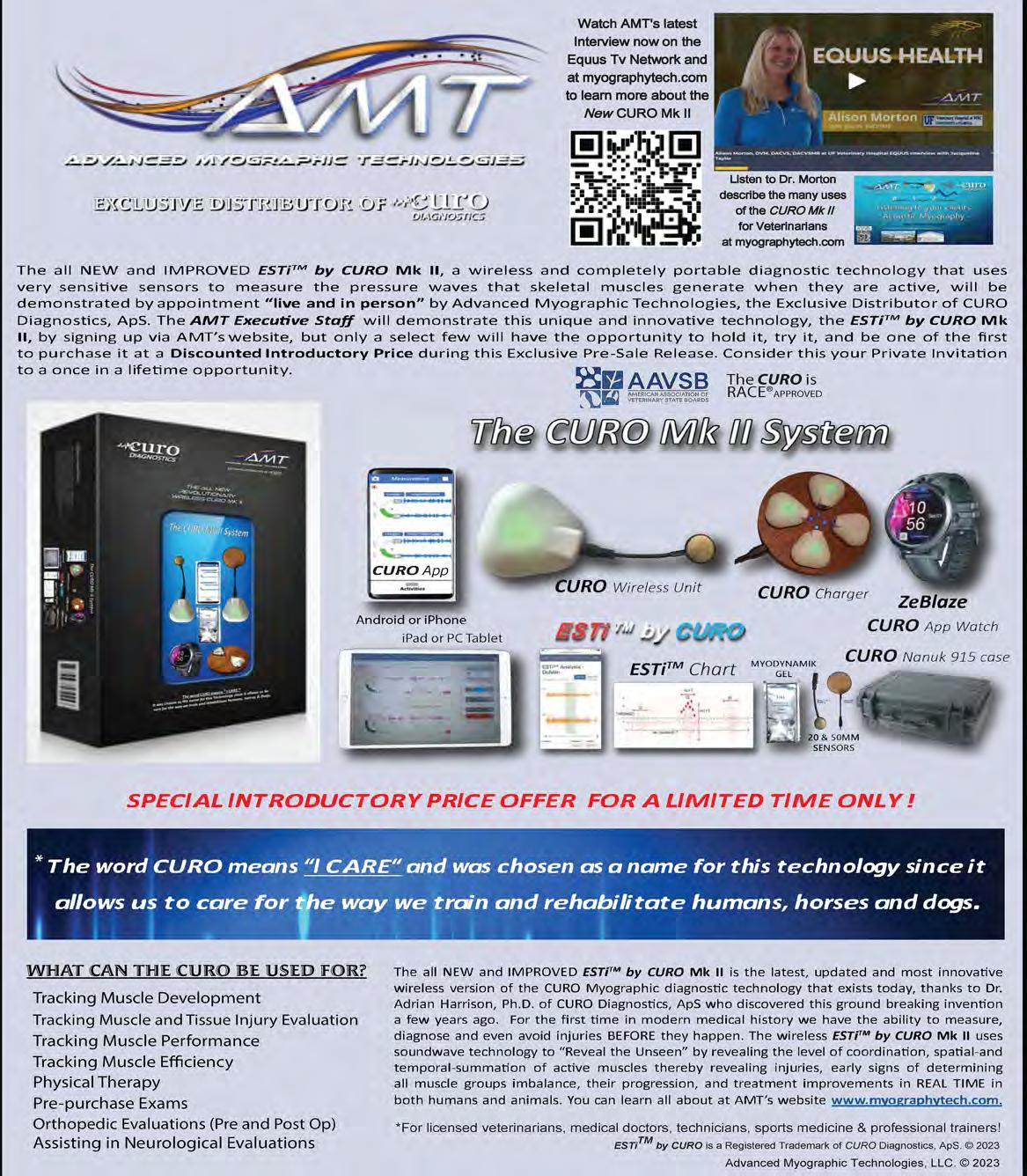



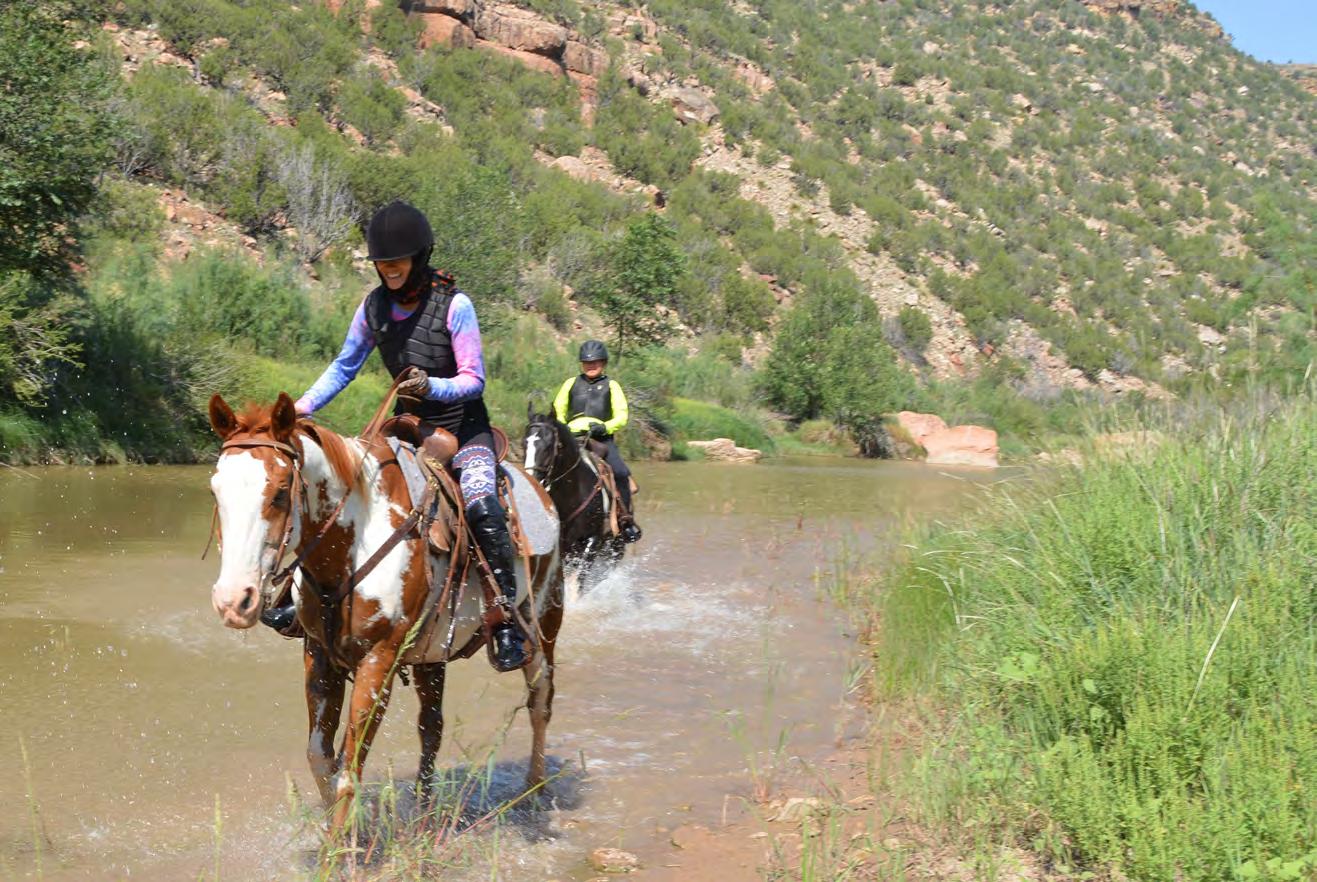


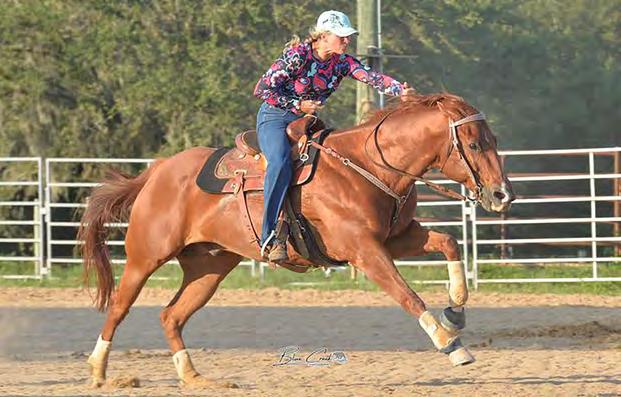
12 Jessie Bonneau Equestrian Extraodinaire 18 Persistence Sculpture by Tyrel Johnson 28 Two Sisters... And A Historic Ranch Adventure 32 Audra Tyson Florida Barrel Racer 36 Equine Health An Introduc�on To Hanna Soma�cs for Horses 40 Ty Murray Exclusive Interview 42 TACK BOX Your source for services & great retail finds! CONTENTS Western Equestrian® Fall 2023
12 COVER STORY ������ �������� ����� 20 40 32
Photo by Jessie Bonneau


��������
EDITORIAL STAFF
Editor-in-Chief: Noelle Vander Brink
Art & Antiques Editor: Dr. Lori Verderame
Equine Art Editor: Jeanne Chisholm
Fashion Editor: LA Sokolowski
Legal Editor: Avery S. Chapman,Esquire
CONTRIBUTING WRITERS
Patricia Hechter
Diane Holt
Lynn Palm
L.A. Sokolowski
GRAPHICS Fran Sherman
Canyon Madness Ranch is an unforge�able experience for
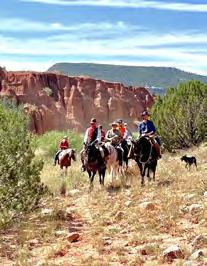
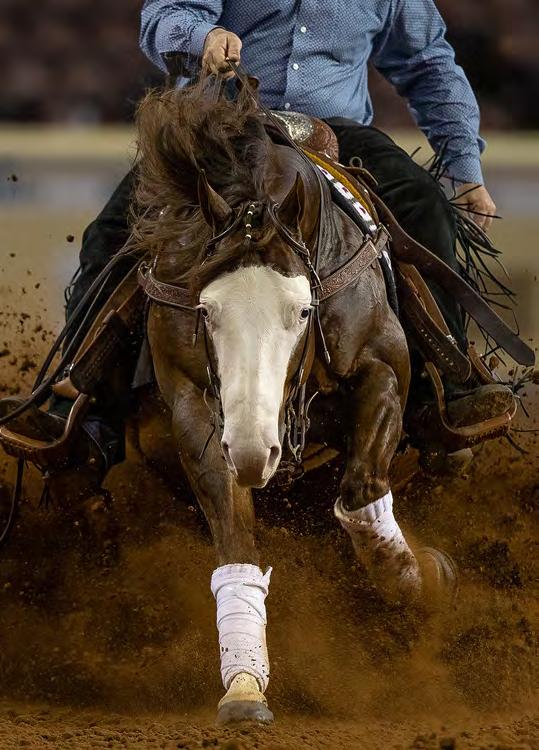
ADVERTISING
Advertising Sales, N.E.Region: Kathy Dress 610-420-9964 kdress@ptd.net
Advertising Sales, S.E. Region Karen Eagle 352-812-1142





Advertising Sales, National: Diane Holt 713-408-8114 diane@eliteequestrian.us












CONTRIBUTING PHOTOGRAPHERS
Jessie Bonneau
Katerina Gaveta Wallace
Blesk Photography
Diane Holt

A Special Edition of Elite Equestrian® magazine Published since 2008
a horse is not a gentle hobby, to be picked up and laid down like a game of solitaire. It is a grand passion. Ralph Waldo Emerson www.EliteEquestrianMagazine.com info@EliteEquestrian.us • Main Office, Ocala, Florida PUBLISHER Bill Vander Brink Bill@EliteEquestrian.us
Riding
On the cover... Copyright © 2023 Elite Equestrian is a registered trademark owned by Elite Equestrian LLC. No article, photo, or part of this publication may be reproduced wholly or in part without written permission of the publisher. Management reserves the right to approve or refuse any advertiser or contribution for any reason. EE does not endorse any product or advertiser and is not responsible for accuracy of info/opinions provided by advertisers or article content. Photographs are submitted by writers of each article who assume responsibility for usage approval.
EQUESTRIAN LIFESTYLE MAGAZINE IN THE U.S.A. According To Feedspot blog #5 IN THE WORLD #1 WESTERN Celebrating Western Equestrian Lifestyle EQUESTRIAN Fall 2023 www.EliteEquestrianMagazine.com Canyon Madness Ranch Experience of a Lifetime Ty Murray Exclusive Interview Jessie Bonneau Tyrel Johnson Audra Tyson Hanna Somatics® Inspiring Equestrian Sculptor Barrel Racer Great For H
® Celebrating Western Equestrian Lifestyle
your family to enjoy!
WESTERN
EQUESTRIAN

essie Bonneau
Equestrian Extraordinaire
Born in the USA, raised in France, Jessie’s first experience on a horse was at the age of 2 years old. She started riding in a Pony Club at the age of 6 and then trained in the South of France. From a young age, Jessie was very interested in the different horseback riding disciplines such as Dressage, Jumping, Eventing (she competed at a high level in all 3 disciplines) Vaulting, Horseball and Spanish riding (Andalusian and Lusitano dressage show and events). She wasn’t a big fan of Dressage at first when she was a kid (boring circles and too slow compare to jumping and eventing). She was doing well in eventing competitions but realized the importance of the Dressage part to win a show. So, she started to refine her skills in Dressage.
Jessie went to the Sport University in France; she graduated with a Bachelor of Sport Management and Marketing and became an independent Horse Trainer.
In 2007, Jessie moved back to the United States. She rode and trained as a jumper in Wellington, Florida for a year. In 2008, she moved to Las Vegas. Jessie got a great opportunity to be the head trainer for 3 years for a famous Medieval Show “The Tournament of Kings” at the Excalibur Hotel in Las Vegas, mixing Western riding skills with jousting, sword fighting and javelin.

On the side of working at night at the Medieval Show, Jessie built her business “JB Horse training”. Her business involved teaching kids and adults, pleasure and competition, beginners and advanced riders, special needs kids; training horses, working on different disciplines such as Dressage, Hunter/Jumper, English Pleasure, Western Pleasure, Western Dressage, Horseball, Vaulting, Young Horses. She also competed in Dressage, Hunter/Jumper, Arabian Shows, Western Dressage, English and Western Pleasure. Jessie specializes in training rescue horses. Her own horse, Skies the Limitt+/, is a rescue stallion.
Jessie came all the way up to Grand Prix Dressage, since acquiring her stallion,Skies the Limitt+/ in less than 7 years of showing. Jessie has earned the following accolades for her riding skills.
2023 USDF Gold Medalist
2023 AHA Region 7 Champion Western Dressage Level 5
2023 AHA Region 7 Champion Western Dressage level 4
2023 WDAA Lifetime Point Bronze Medalist
Jessie not only accomplishes, but somehow manages to stay on top of anything and everything equestrian while training her clients and their horses on a rigid six day a week work schedule. So much so, Jessie is slated to embark upon a 1,200 mile journey across the US in late September in order to support four of her clients (plus herself) in their upcoming quest to compete at the 2023 WDAA World Championship, held at the Lazy E Arena in Guthrie, OK. As diverse as Jessie’s training background, each and every rider/horse team client she will be coaching at the 2023 WDAA World Championship Show brings an equally colorful and diverse back story to share.
Valerie Porter will be competing with her rescue horse Ginger 360, a pretty and sweet 20 year old Thoroughbred mare who successfully competes with just one functioning left eye. Ginger 360 was rescued by HOPE4HOOVES, (find them on FB at Silver State Western Dressage SSWD) a non-profit group that helps to save horses from neglect and abuse. Just as Valerie saved Ginger’s life, Valerie gives the same level of respect back to Ginger, sharing how Ginger motivated Valerie to get her own personal health on track by losing weight and getting in shape in order to get back in the saddle and ride once again. Valerie and Ginger will be showing as an Amateur Rider Team – Introductory Level.
Lisa Gabaldon (right) will be showing with her roan gelding, Chuck’s Last Roan. A sensitive yet challenging and bold personality, Chuck is an 18 year old with a very colorful

12 www.EliteEquestrianMagazine.com
EQUESTRIAN Fashion
J

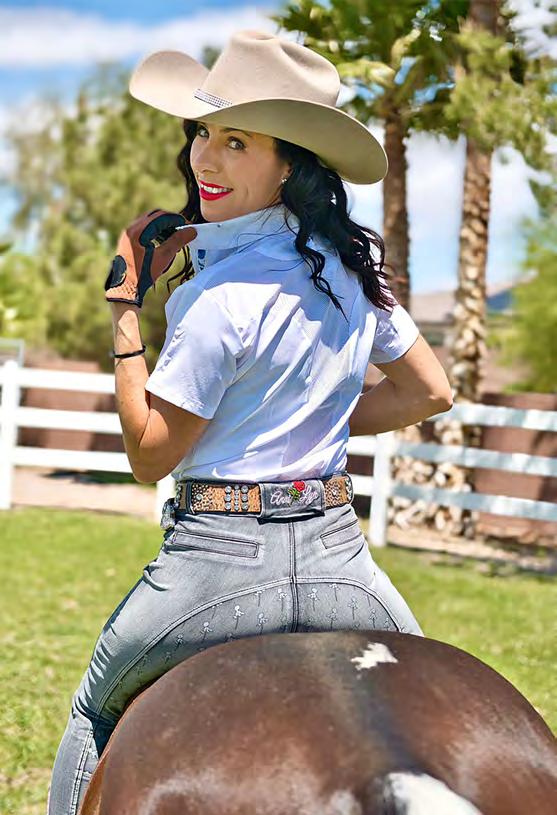


www.EliteEquestrianMagazine.com 13 Continued...
Lisa Gabaldon and Chuck’s Last Roan.
Jessie with Skies The Limitt+/ wearing Anni Lyn Vibrant Horse L/S Show Shirtt & Anni Lyn FlexFit Cabretta Glove. Photo by Katerina Gateva Wallace
Jessie is wearing an Anni Lyn Ventilated Show Shirt and Anni Lyn Denim F/S Breech. Photo by Katerina Gateva Wallace
Jessie is wearing Anni Lynn Vibrant Horse ProAire S/S Shirt,
Photo by Katerina Gateva Wallace
past, who (before Jessie) had been bounced around from trainer to trainer. Known for bucking off many if not all of his previous encounters, Jessie and Lisa were able to work patiently with Chuck to get him to relax and re-center his energies from what had once been big bucks into beautifully articulated western dressage movements. Lisa and Chuck will be showing as an Amateur Rider Team – Level 1.
Dr. Leslie Browder and her horse Equinox (aka; Nox, owned by Leslie’s husband Tim) will be competing as an Amateur Rider Team in Introductory and Basic Levels. Equinox is a massive, yet loving 16 year old Bay Clydesdale cross gelding who was just a simple pasture horse in his former life. Nox, scared of his own shadow, was a fearful and spooky horse until Jessie and Leslie took the time (and numerous cookies) to work with him countless hours physically and mentally to establish a new found trust.
Jami Teer-Murphy will be competing with her magnificent 17+ hand Friesian gelding, Xavier of Winchester Acres (aka; Mr. X.) Mr. X became Jami’s equine partner at the young, very green age of just 5 years old. Jami took on a massive challenge with her gentle giant knowing that Mr. X had virtually little to no formal training at the start of their journey back in 2020. With an abundance of love, education, patience and dedication to consistent training, Jami and her young protégé have evolved tremendously. Jami and Mr. X will be competing as an Amateur Rider Team – Basic Level and will perform in an entertaining Basic Musical Freestyle Performance.
Finally, Jessie will once again travel to Oklahoma with a World Grand Championship Title set high in her sights on her own personally rescued stallion, Skies the Limitt+/ (Sky). Sky’s rescue story is as unique as Sky and
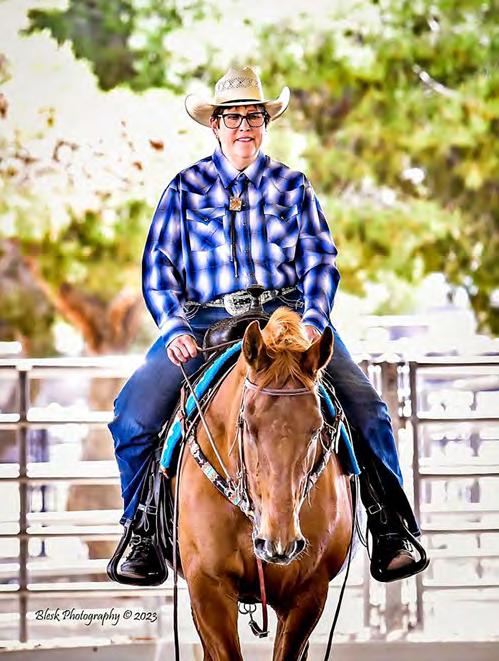
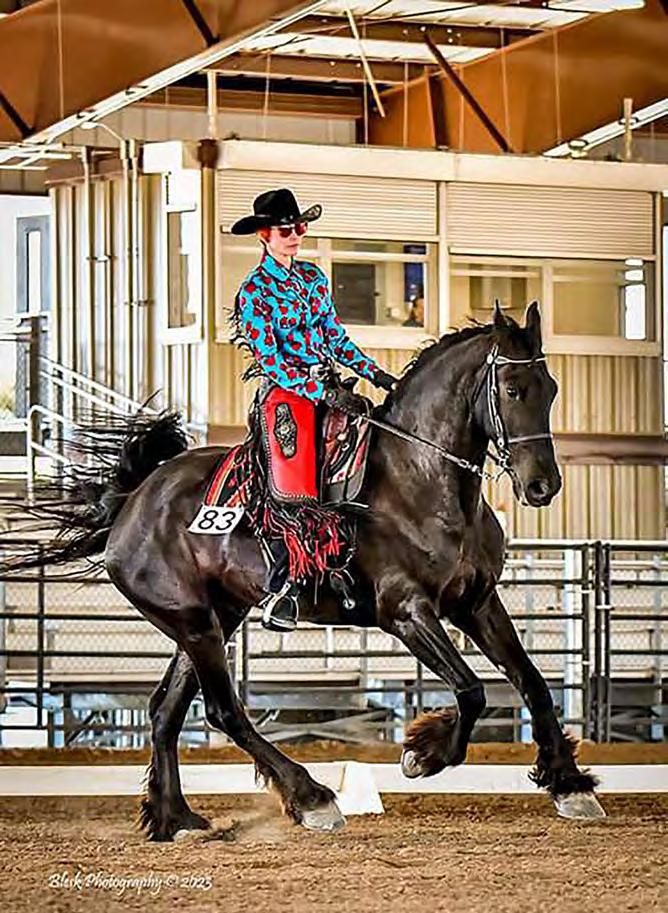
Jessie’s remarkable accomplishments. Though Jessie and Sky had seemingly met each other through a previous client relationship early when Jessie first relocated to the US, it was a few short years later before they would begin their own personal journey together.
Arriving in the US from France with just two suitcases in hand, Jessie endured a multitude of challenges that come along with relocating to a new country and city where you have no roots or relationships to support you. At the height of these challenges to her chagrin, Jessie crossed paths with Sky a second time. Only this time Jessie witnessed Sky in a neglected, ignored and seemingly unloved heart-breaking situation. It was then and there where Jessie committed to doing whatever it took to give Sky the second chance in life he deserved. From this day forward, Jessie worked tirelessly to transform Sky into the a meaningful equestrian partner and now World Recognized Champion athlete that he is today with her unconditional love and leadership. Since that day, Jessie’s own personal dreams have also become a reality as a result of the unbreakable bond she and Sky have built together. Riding up through each and every level of both Classical Dressage and Western Dressage disciplines from start to present day, Jessie will be competing with Sky as an Open Rider – Level 5. We are optimistic to see another Grand Champion Title in their hands soon!
14 www.EliteEquestrianMagazine.com
Valerie Porter and her rescue horse Ginger 360.
Jami Teer-Murphy and Xavier of Winchester Acres
�������
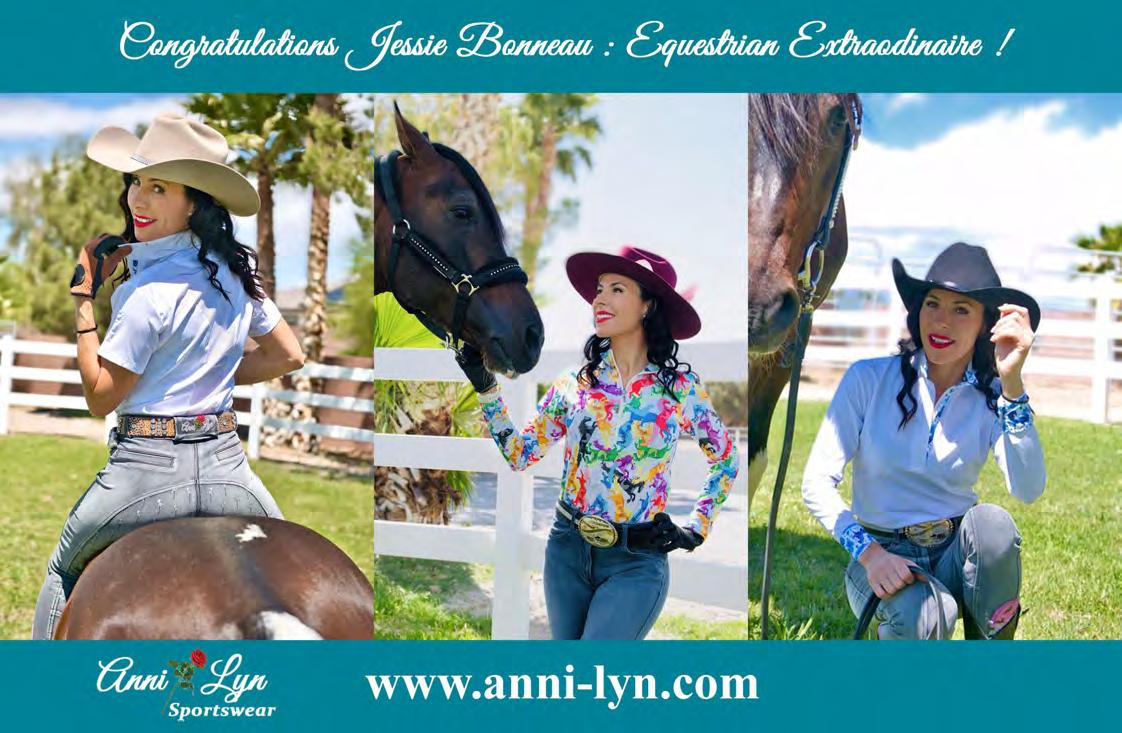
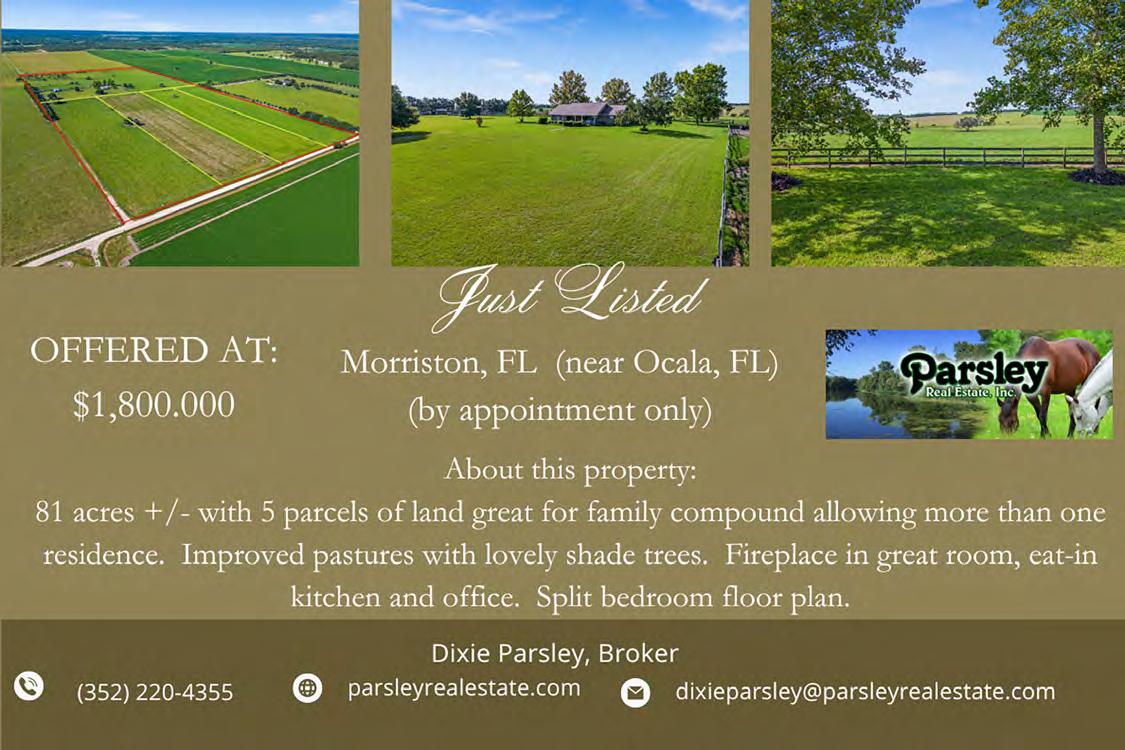
www.EliteEquestrianMagazine.com 15
Though Jessie is proud of her own personal riding accomplishments, she takes the most pride in honoring her relationships with the diverse group of ladies that put their trust in her, that are highlighted above. Together they have built a unique bond not only among themselves, but with their horses and each other. You can watch the 2023 WDAA World Dressage Show live in Guthrie, OK, September 26-30, 2023 on “Total Horse Channel” (totalhorsechannel.com).
Jessie is also the proud Ambassador of numerous International brands and is steadfast in her efforts to highlight and support awareness of each and every one of them as they continue to support her and Sky in their equestrian endeavors.

Jessie’s Partnerships:
• Schleese Saddles (schleese.com), where she was recently received a brand new custom western saddle “The Cadence” as a collabora�on/sponsorship.

• NACA Helmets (nacahorse.com) Newly developed equestrian helmet designed for ul�mate in safety, beau�ful and advanced design; and the Gravity Helmet is well known for its light weight, breath-ability, fit and performance.
• Anni Lyn Sportswear, LLC (anni-lyn.com) Anni Lyn is well known for their colorful, casual sun shirts and other coordina�ng accessories.
• WDAA – Western Dressage Associa�on of America (westerndressageassociaton.org)
• WDAA World Show – (wdaaworldshow.org)
• In 2022, the World Show had 55 Breeds, 233 compe�tor teams and over 1000 tests ridden and judged.
• CAWDA – California Western Dressage Associa�on (cawda.org) This is the California/Nevada affiliate of the WDAA.
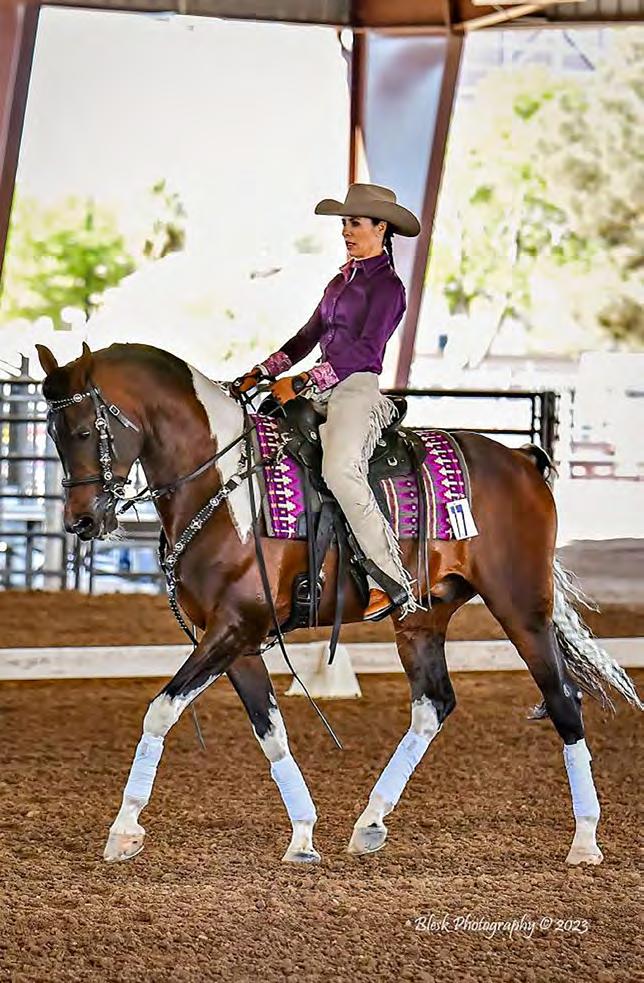
16 www.EliteEquestrianMagazine.com WE EE
Dr. Leslie Browder and Equinox .
Jessie with Skies The Limitt+/ wearing Anni Lyn Mythical Horse ProAire Shirt & Anni Lyn Denim F/S Breeches. Photo by Katerina Gateva Wallace
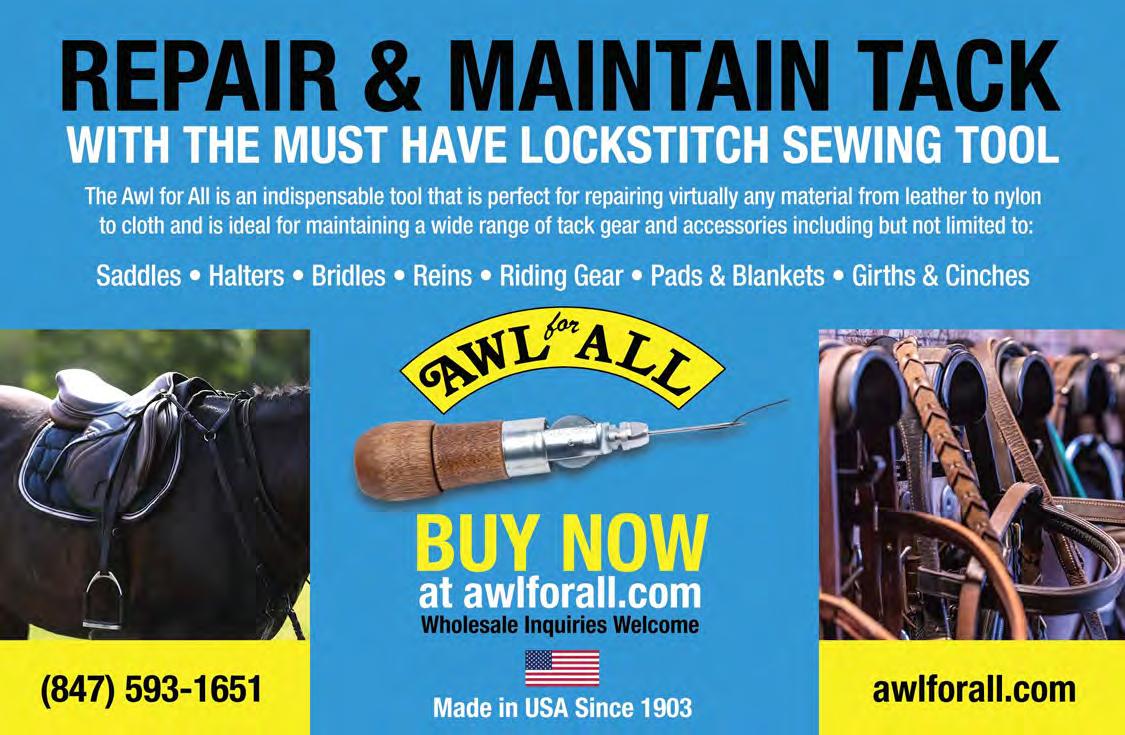
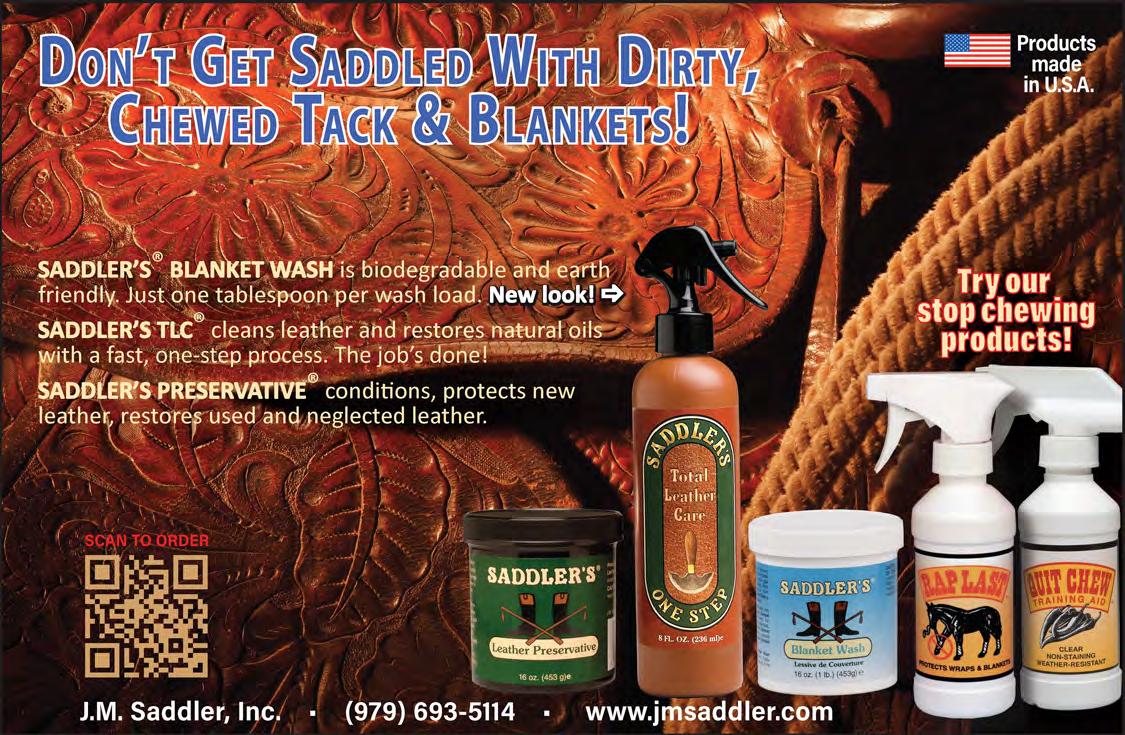

www.EliteEquestrianMagazine.com 17
“
TTyrel Johnson hrough life’s trials
Con�nuance of Ac�on,” ... a magnificent shire dra� horse leans into the collar, dragging a seemingly immovable block of argillite stone, appearing to create grooves in the sculpture’s walnut base as it makes grueling but percep�ble progress.


As Tyrel says the piece is “all about persistence. Persistence through life’s trials is a consistent theme in my life and my art. The triumph of love and the human spirit is at its highest when contrasted to the trials it endures.”
������� orbels C
Horse Head Sentinel
A lovely accent to go on either side of an entry or porch, and could also be a mantle support.


18 www.EliteEquestrianMagazine.com EQUINE Art
PERSISTENCE
These stylisy Gypsy corbels are specific to the mantle but could be used in other ways.
“Continuance of Action” Bronze,
Stone, and Walnut 56″ Wide 17″ Tall 13″ Deep $14,450 Edition of 30
Argillite
Horses...


Architectural Elements...

www.EliteEquestrianMagazine.com 19 ������������������������������������������ ����������������������������������������������������� ������������������������������������������������������ ������������������������������������������������������ ������������������������������������������������� ����������������������������������������������� ������������������������������������������������������ ������������������������������������������������������ ��������������������������������������������������� ����������������������������������������������������� ���������������������������������������������� ���������������������������������������������������� ���������������������������������������������� �������������������������������������������������� �������������������������������������������� ������������������������������������������ ����������������������������������������������� ���������������������������������������������� ���������������������������������������������������� ������������������������������������������ �������������������������
“ “
WE www.tyreljohnsonfineart.com
Pure Madness? EQUESTRIAN HEAVEN An or
is it
Story and Photos
By Diane Holt
Canyon Madness Ranch in northeastern New Mexico is just five hours from Denver, two hours from Santa Fe and three hours from the airport in Albuquerque. This special ranch offers guests an exceptional time warp adventure to connect with nature and horses and to simply unplug. This is NOT a dude ranch. Dennis Law, a retired surgeon, built this extraordinary ranch oasis on 14,000 acres where the horses roam free and guests can savor a “back-in-time” vacation with 21st century luxuries.

EQUINE Lifestyle
As you step inside the 18,000 square foot modern guest house known as the Teepee Lodge, you are completely overwhelmed by the magnificent river canyon view. Two massive decks hover over the cliff edge above a steep descent to the Canadian River 800 feet below. The grandeur and majestic beauty will knock you to your knees. The crevices between the canyon walls are called arroyos. They were created by masses of water and are 20 to 100 feet wide and up to 20 or more feet deep. “You might think you are on Mars except for all the green in the landscape.” said Law. I have to say that I completely agree with him.

Canyon Madness Ranch offers two main bookend adventures. There is an equestrian paradise with outstanding horses and a firearm sports playground to please your heart. One day you’re riding a trail along the canyon edges all the way to the river bottom, passing old 19th century Native American homestead sites. The next day you’re shooting a Barretta M82-A1 (50 cal.) from a veteran’s Humvee that was used in the Iraq war

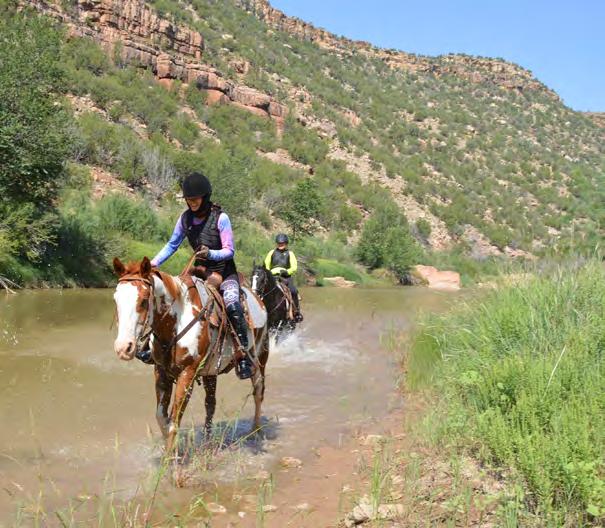

www.EliteEquestrianMagazine.com 21 Continued...
For the equine enthusiasts,
like myself, it made my heart warm just seeing the mix of well-bred and trained quarter horses, paints, gypsy vanners and gypsy crosses in one large herd roaming free over 14,000 acres. At CMR they are living life as nature intended, yet still being cared for by expert horsemen.
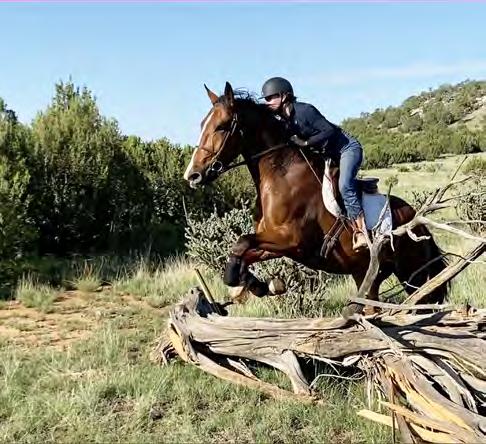



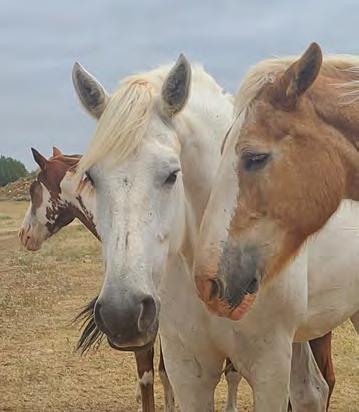



The ranch has a wonderful covered arena for focused training and lessons. The horses are schooled in different disciplines to ensure safe and secure mounts which cater to a variety of guest hobbies such as English cross-country trail riding, obstacle course training, jumping, western-style reigning, cutting cow herding and more. CMR offers a range of riding experiences to guests from beginner through expert level in any discipline.
A favorite for our group were the breathtaking trail rides along the canyon edges down to the river. Our adventures allowed us to explore in extraordinary proportions and take in the legendary views. This is NOT a “nose to tail” ride. You ride at your level of comfort but expert guides are there if needed. Regardless of what horse breed you prefer, I can promise that you will fall in love with CMR’s horses and want to bring your mount home with you. I am still trying to figure out how to get “Jughead”, a Percheron/quarter horse cross, home with me. This big gentle giant carried me on trails along the canyon with drops that were hundreds of feet below.

If you like shooting firearms or have never shot one before, this is the place to enjoy it. CMR has a state-of-the-art firearm playground. Kip Rahmig, the ranch certified professional instructor, took us all shooting. I have always been a bit nervous, well truthfully extremely nervous, around firearms. Kip brought out an astonishing array of pistols and rifles, some automatic, including a massive 375 Cheytec long range rifle. I could seriously feel my heart beating faster thinking I don’t want to do this. Well after some incredible guidance from Kip and his team, I found myself popping off targets left and right. My apprehension about handling firearms quickly disappeared.
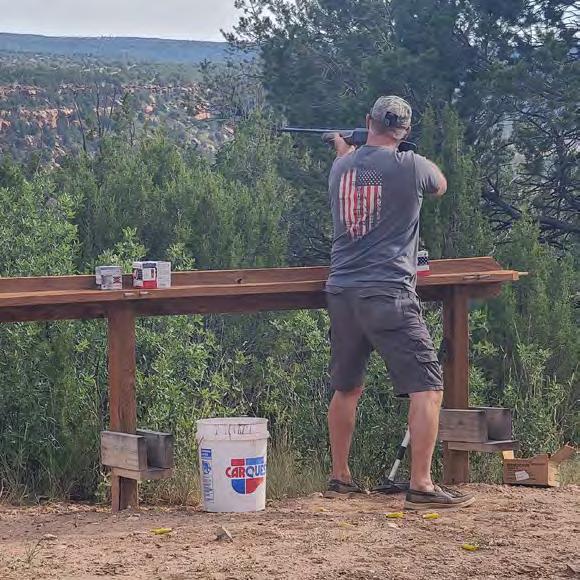
22 www.EliteEquestrianMagazine.com





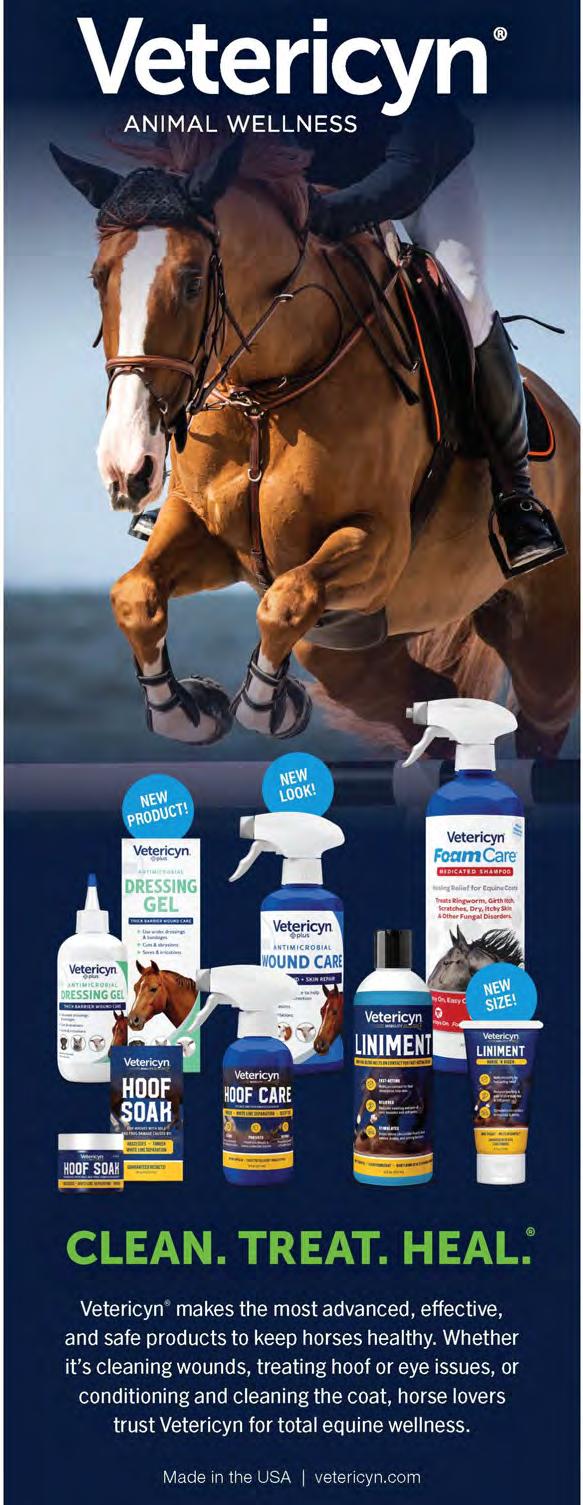
www.EliteEquestrianMagazine.com 23 Continued...
The firearm program is designed to appeal to all. There is a full range of options with guided instruction and safety lessons for amateur hobby shooters to professional expert firearms enthusiasts. I have to say I haven’t forgotten the quote Kip used “Until you’re ready, keep your booger hook off the bang switch.” My husband had one of his best experiences shooting with a 375 Chey Tac and a (50 Cal) BMG snipper rifle with bullets 4” long. To my surprise, this firearm playground was one of my favorite parts of the trip.

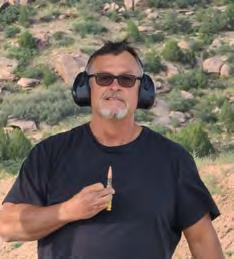
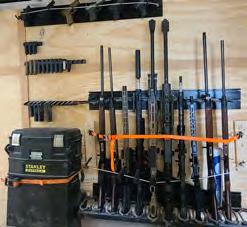
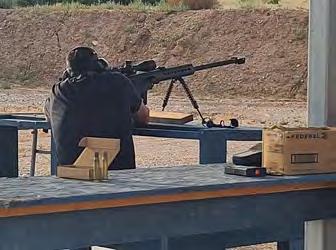
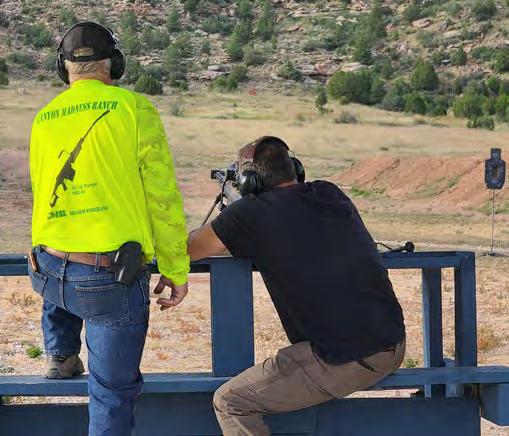
When you search the internet for ranch vacations, you will find very few ranches that offer both horse and firearms sports. If both are offered, then you will find at least one side of it is rudimentary. I would say that NO vacation ranch anywhere comes close to the complete offerings CMR has in those 2 bookend adventures.


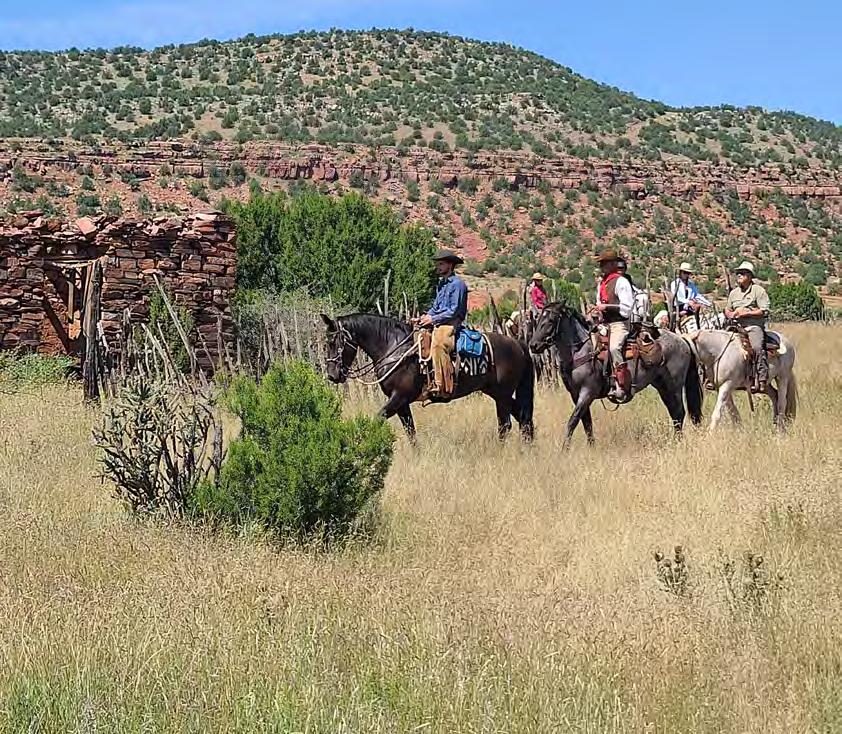
In person the scale of this magical place is overwhelming with incredible geological formations of countless deep fissures in the red-crusted ground which set the stage of New Mexico’s legendary kaleidoscopic sunrises and sunsets. This pristine landscape is a nature enthusiast’s dreamland. Pictures do not do it justice. It is definitely a “bucket list” trip!
The Canyon Madness Ranch is an all-inclusive destination. The kitchen puts an emphasis on a farm-to-table bounty and chefs focus on healthy, organic exotic meats like farm raised buffalo and ostrich, plus of course beef. The ranch also is home to an ostrich farm with two adults producing fresh eggs for the menu. I highly recommend requesting a homestyle meal cooked on a firepit either out on the range or on the back porch to truly enjoy the real ranch experience. The ranch staff was another one of the best parts of our visit. We loved gathering with them, listening to stories and learning from them. We left as friends, not as guests.
24 www.EliteEquestrianMagazine.com EQUINE Lifestyle
If you like shooting firearms or have never shot one before, this is the place to enjoy it.
More...



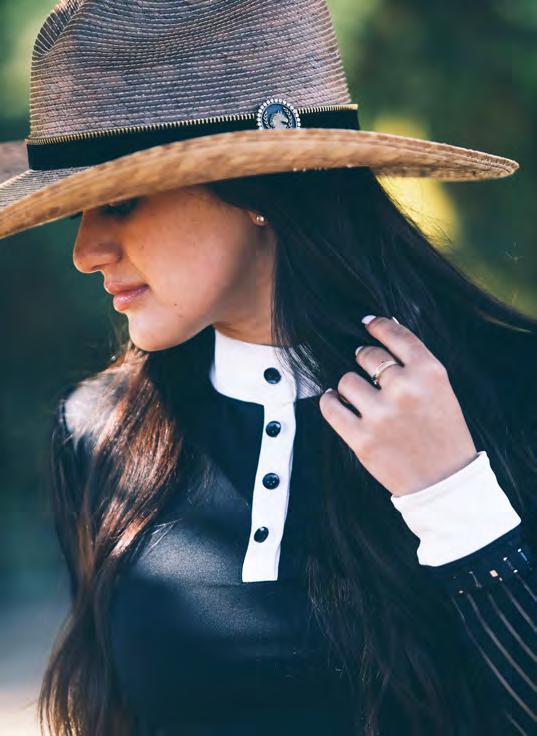

www.EliteEquestrianMagazine.com 25 ���������������� • Lacking Energy? • Dull Looking Coat? • Low In Stamina? • Slow Recovery After Work? Immunall has proven to help many horses from amateur riders to the top race horse trainers from all over the world! ���������������� • Slow In Warming Up? • Stiff Muscles or Joints? • In Need of Muscle Detox? Muscle and Joints helps the muscular system to release waste products to improve suppleness. ����������������������� �������������������������� 916-203-1821 www.rainbowequus.com riatadesigns.com Riata Buckaroo Howdoo Buckaroo!
The timeless saying “pictures are worth a thousand words” doesn’t hold true here. You have to experience it in person to fully grasp why Canyon Madness Ranch is that rare breed of madness!






Thank you, Canyon Madness Ranch, for a lifetime of memories and experiences never to be forgotten.
You can book the entire ranch (eight contemporary suites with living rooms) or book a few rooms by contacting Canyon Madness Ranch directly.
For inquiries and bookings, prospective guests are welcome to call Ashley at 720-878-9676 during office hours for inquiry or email awang@lawbrothersgroup.com.
26 www.EliteEquestrianMagazine.com
Dennis Law on Vader
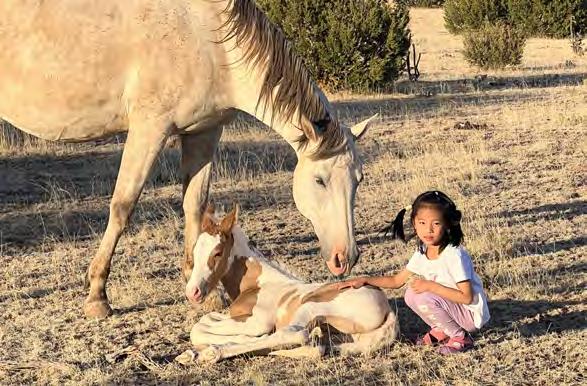

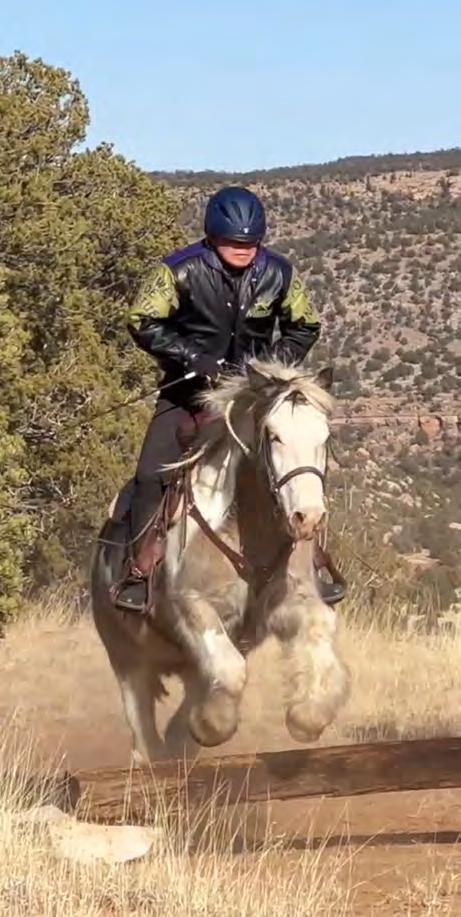


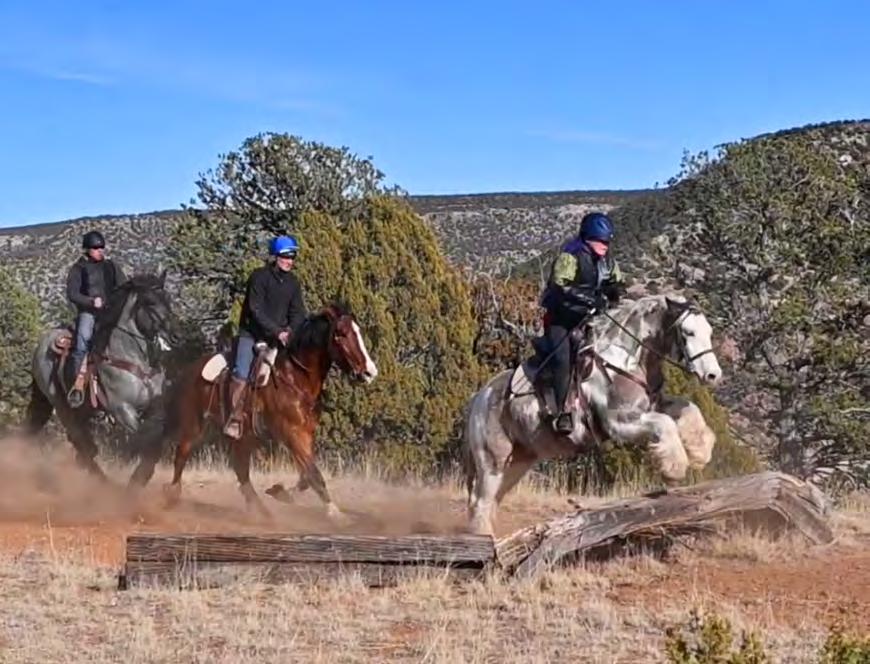

www.EliteEquestrianMagazine.com 27 EE
Two Sisters
One
Historic Western Ranch Adventure Truly, it was the trip of a lifetime!
By L.A. Sokolowski
“Our experience was be�er than we could have imagined. The team and guests felt like family off the bat, the views and landscapes redefined breathtaking, and the horses were incredible and so well cared for!”
Their greatest goal with their audiences, the sisters say, is to always promote a unifying love for horses and riding, regardless of experience, discipline or financial means. A goal that meshed perfectly with the love and passion for saving great western dude ranches behind the True Ranch Collec�on’s O.T.O. Pop-Up Ranch, produced by Ranch Preserva�on, in coopera�on with the Custer Galla�n Na�onal Forest, and provided through Ac�ve Riding Trips.
Instagram and TikTok influencers and horse lovers Madison and Reagan Ibach announced to more than one million @IbachMedia fans about their “phenomenal” three-day stay over the summer at Montana’s oldest and most legendary dude ranch, the O.T.O. Ranch at the North Entrance to Yellowstone National Park.

28 www.EliteEquestrianMagazine.com
“ ”
Last August
marked the first �me since the O.T.O. closed its doors 84 years ago that it has hosted guests, including the sisters, and with proceeds from the pop-up experience going towards preserving and restoring the original facili�es. Historically, the O.T.O. lodge and its outbuildings set the standard for what a western dude ranch was supposed to look like. It also influenced the Arts and Cra�s Movement found in Yellowstone Na�onal Park. The O.T.O. was among western cra�sman Thomas Molesworth’s first commissions and some of his original works can s�ll be seen there today.
The O.T.O. operated as a dude ranch from the 1910s to 1930s and is listed on the Na�onal Register of Historic Places. In 1887, its founder, Dick Randall, was driving stagecoaches in Yellowstone Na�onal Park and earning the nickname Pre�y Dick because his passengers tended to be its wealthiest and most prominent visitors.

Later establishing himself as a reliable ou�itter for hun�ng and pack trips, the �reless entrepreneur began cour�ng “city dudes” as steady business.
In 1898, Dick and his wife Dora purchased land in a mountain valley along Cedar Creek where they began ranching and growing hun�ng and pack trips clientele. In 1912, the O.T.O. Ranch officially opened to “dudes,” and the construc�on of a main lodge, shower house, and more cabins soon followed.
According to Dick, whose colorful stories have been captured in a wri�en history of the ranch, Music, Saddles and Flapjacks, the origin of the ranch’s name was simple: “We had a brand at the ranch; it was OTO and didn’t mean anything in par�cular. Each ranch has a brand on all livestock and the simpler the brand, the be�er.
www.EliteEquestrianMagazine.com 29 Continued...
“This one didn’t blotch and I could make it with an iron ring and a straight bar. If I was out on the range and saw one of my cri�ers wasn’t branded, I could make one with an iron ring, a pair of pliers, my case knife and a li�le brush first.”

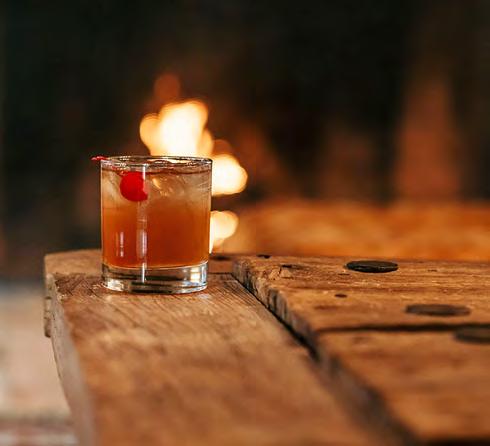
Dick and his wife Dora made promo�onal trips back East promising a western-style experience full of horseback riding, fishing and an escape from urban life, while helping with ranch chores like round-ups, milking and gardening. Guests enjoyed food produced on the ranch, entertainment ranging from music to dancing to storytelling, and even riding in the Livingston Rodeo parade with the Randall family.
While the heyday of the O.T.O. dude ranch only lasted un�l 1939, its pop-up revival for a new genera�on of riders and horse lovers promises to keep the Old West feeling like a brand new experience.

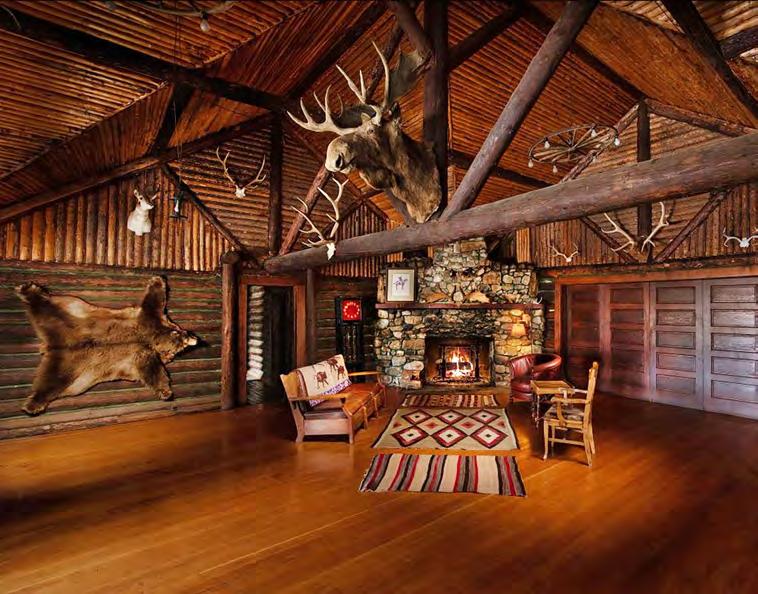
“We were amazed by and deeply apprecia�ve of the planning, organizing and kindness leading up to and during our stay at the O.T.O.,” the sisters agree. “Ac�ve Riding Trips made sure it was an unforge�able trip.

“All we had to do was get excited and enjoy.”
Somewhere, Dick and Dora are smiling. WE
30 www.EliteEquestrianMagazine.com
Madison Ibach
Reagan Ibach
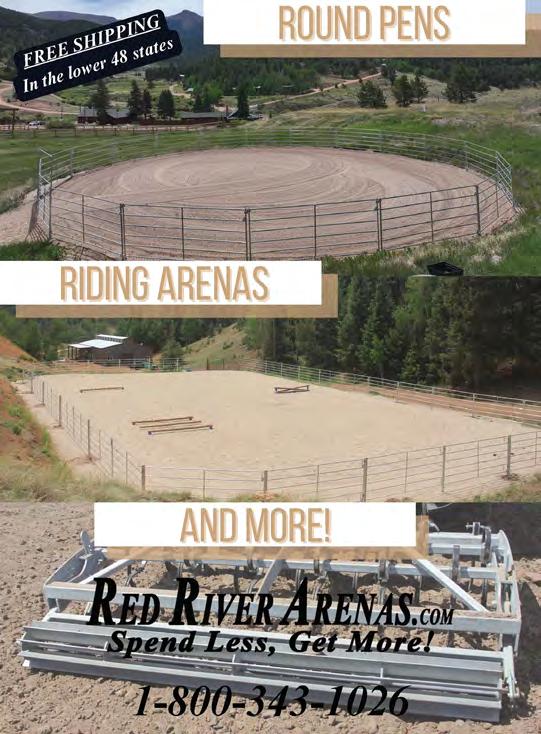



www.EliteEquestrianMagazine.com 31 Poll Cap Back Saver Hock Saver Ankle Saver Tendon Saver Tendon Saver www.revitavet.com
She’s A Firecracker:
Florida Barrel Racing’s Audra Tyson
 By L.A. Sokolowski
By L.A. Sokolowski
In addi�on to her own �tles, Audra can light a fire under her students, like Crosby sisters Haylee and Heaven, winners (respec�vely) of 2018-19 Miss Silver Spurs and 2022 Miss Teen Rodeo Florida �tles, and last June, Rachel Sasse Wire thanked her for the role she has played in their horse-loving family’s life.
“Every now and then you are blessed to have someone in your life that truly cares about you and your family,” she said. “I am thankful for Audra and her generous heart, and how she turned our li�le girl into a Rodeo Queen,”
In the pen, riding her 10 year-old AQHA chestnut gelding, Firen La Jolla, aka The Hemi, Audra has shaved seconds off her cloverleaf pa�erns while shaving more than 35 pounds off the scale thanks to riding and living with a healthy outlook.

“Four years ago, I lost 38 pounds in nine months,” Audra says. “And I kept it off by staying on a program that I learned from an online coach, who was a nutri�onist and weightli�er, I found on Instagram.” She started working with the coach online during COVID because, “No one could get to a gym anyway.”
Now planning a healthy program of meals is as a comfortable a habit as finding a deep seat in the saddle.
Instead, she says, go for it. “Whatever you’re doing, do it with the confidence of a four-year-old kid in a Batman t-shirt.”
32 www.EliteEquestrianMagazine.com
2009 AQHA Firecracker Circuit Open All-Around Champion barrel racer Audra Tyson, of Tyson Colt Company in Fort McCoy just outside of Ocala, doesn’t let the word can’t enter her vocabulary.
“I prep meals a week in advance. Then it’s easy to just grab, eat, and go.” Instead of building a menu around three big meals a day, “I have five or six small meals. Including four ounces twice a day of chicken or fish, and protein shakes,” she says.





www.EliteEquestrianMagazine.com 33 Continued...
“I’m the kind that, once I set my mind to something, I do it. I’ve been told it takes 30 days to change a habit. But it really took more than a year for my body to accept the changes to my diet, and say okay, I give in. I s�ll get cravings (I love sweet tea and miss pizza) so maybe once a week I’ll give in to a li�le treat.”
Audra’s training and riding schedule should earn her a treat or two, since a typical day starts around 4:00 a.m., without coffee.

“No coffee,” she laughs, “ but I love my caffeinated energy drinks! I can drink TRUE lemon® packets all day. I’ll have an energy drink before going out to feed the horses and do stalls. Once they eat I eat my breakfast, usually oatmeal and a protein shake.
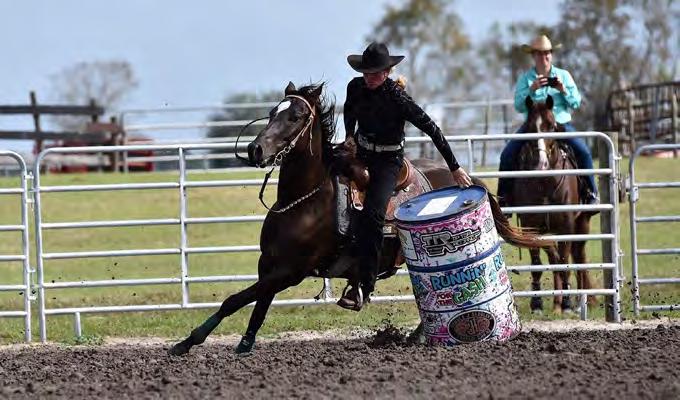


“Then I’ll turn out the horses that have been in, grab one that’s been out all night, saddle up, and start riding. I try to ride three or four horses in the morning before it gets hot. If it’s too hot to ride, I’m doing everything else. Chores. Groceries. Fixing fence lines or pressure washing the barn.
“I run by daylight, not clock, �me. I’m done a�er the last horse is done and it’s dark out,” she says, adding that’s why meal prep is grab and go. “Finally, I’ll pour a tall glass of my lemonade and add two teaspoons of apple cider vinegar. I like the sweet/tart flavor.”
A li�le heat and a li�le sweet: Just like a good barrel horse and pa�ern. WE
34 www.EliteEquestrianMagazine.com





EQUINE Health TRAINING & Showing Fashion 520-906-3817 @uptownrodeorose
An Introduction To
Equine Hanna Somatics®
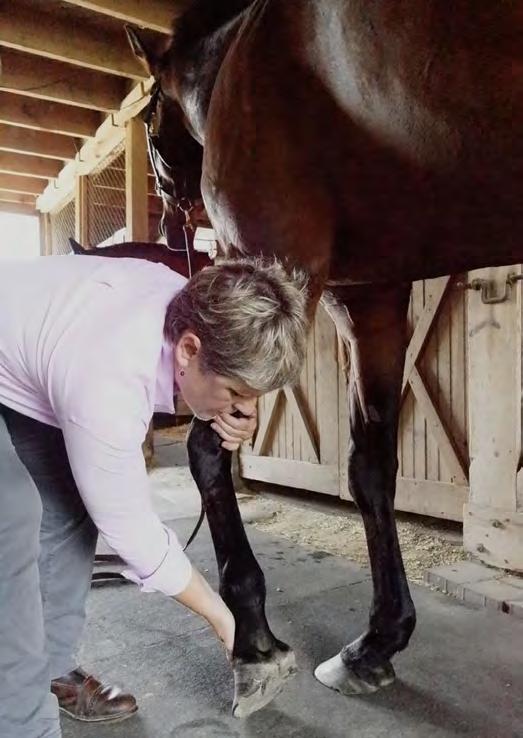
There is a fabulous series of gentle specialized movements for horse and rider which allows each to feel less stiff as they both age. What is this technique?
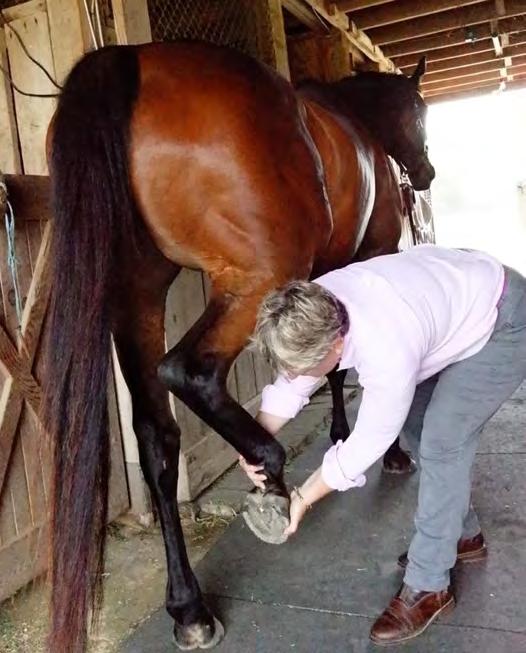
First developed by Thomas Hanna, Hanna Somatic Education®, has been a discipline since the 1990’s.
Story By Patricia Hechter
Photos By Louisa Raske
These movements were developed to improve movement, flexibility and health in humans, equines and canines. Bodies are pulled out of shape by contractions we all have due to events ranging from a small injury, to a major accident. Many of us have childhood injuries, we never thought much of. Well, they can come back to bite us as we age! From being playful frolicking foals, horses can have the same issues. Their human caretakers might not always be aware that anything may have happened.
These “injuries” can create “Sensory Motor Amnesia”. SMA is what happens to the muscles of the body that are contracted and cannot lengthen; with less freedom to move the body gets tight with less range of motion and can lose strength. Hanna Somatic Educators for both humans and horses can assist in teaching how to re-train the body to eliminate those chronic contractions. This allows more flexibility to return, making us feel more supple and able to move more fluidly.
For the Initial Pickup of a Front Limb invite the horse to lift his foot from the ground with your closest hand by the knee. As the hoof lifts away from the ground prepare to catch it with your other hand. If the horse only wants to lift his foot from the ground while the toe remains resting on the ground, this is acceptable. Encourage the horse to take his time returning the foot to being fully weighted upon the ground. The muscle groups involved with this lift are at the scapula, and those that flex the shoulder joint, elbow, carpus and pastern, a total of 15 muscles.
Those who are in the know, understand that horses mirror the weaknesses and balance issues in the bodies of their riders, and, to some degree, those who handle them on the ground. We can learn how to re-educate our own bodies and begin the path to correct those stiff and crooked patterns. We can also do the same for our horses.
While this is not easy work, it is gentle. Somatics doesn’t follow the “No pain, No gain” theory. In Somatics you need to move slowly and gently without pain or discomfort, and release slowly with control until you are at rest. This re-sets the movement patterns allowing more mobility and strength. As the areas of restriction become more mobile, the movements can become larger. All of this happens for the human and the equine.
Another wonderful part of to Equine Hanna Somatics[EHS] is that you can learn how to do much of the basic work for yourself and your horse. To get your toes wet with EHS, here is a simple and effective movement to do with your horse. You will see how your horse’s posture improves and how he demonstrates he is feeling better. Start by taking 4 photos of your horse standing naturally, not posed: front, back and each side.
A safe stance is being demonstrated for the Hind Limb Initial Pickup. There is one hand supporting the hoof and the other hand is supporting the ankle. Breathe comfortably as you are gently supporting the limb and begin to slowly allow the horse to lower his leg and hoof to the ground. The horse uses 19 muscles to accomplish this lift.
36 www.EliteEquestrianMagazine.com
Continued...
Elite Equestrian does not endorse or confirm content suggestions in any articles. See credit page for disclaimer. EQUINE Health
Equine Hanna Soma�cs Educator, Patricia Hechter.
This is an example of Sensory Motor Amnesia, in the muscle groups relating to the hip, stifle, hock and/or pastern. There is a series of contractions that are in the process of lengthening. (The horse is pulling his leg away from the movement.) Maintain a soft feel of the ankle and hoof allowing the horse to know he is supported not corrected.
As the leg returns to the ground, allow the hand that is closest to the horse to slide from the hock to the ankle, if it is not already there. The hand that had been supporting the hoof softens and moves from the center of the hoof toward the pastern.

The horse is invited to participate in his healing experience.
One of the basic movements in EHS is called “Initial PickUps”. To make this a somatic movement, invite the limb to be lifted from the ground as if cleaning the hoof. Choose the leg to be lifted by gently placing your hand above the knee of the forelimb, [and by the hock on the hindlimb]. As the horse lifts, allow your hand(s) to slide to the front of the leg/ankle area. Pause slightly, then slowly allow the horse to lower the leg back to the ground. Be sure to have the horse fully weight the foot once it reaches the ground, not resting the toe of the foot, to complete the movement. Repeat 2 more times. Continue with the remaining three legs.
Things to be aware of: The horse may slap his foot back to the floor. He may experience some pulls, jerks, or a handful of other movements during the descent. Allow the movements to occur, while maintaining light contact, doing as
little as possible, guiding the horse’s limb to gently reach the ground. The jerks, pulls and other movements your horse may exhibit while completing the movements, are examples of SMA. He is not being mean or difficult. He is working through a contraction to find a way to have his foot where you are asking for it to be located.
To observe a before and after of your horse, take 4 more photos after the session. Then compare the images side by side.
EHS is particularly special and effective because the horse is invited to participate in his healing experience. The specialized movements work within the horse’s comfort zone whether very limited or not. He will feel better, and his posture will convey that.
Trish Hechter grew up riding and working with her mother in Maryland who was renowned for working with “problem” horses. In the mid 90’s Trish earned her Reiki 1 and 2 certificates becoming a Reiki Master in 2020. After meeting Ryan Moschell, a certified Hanna Somatics Educator® based in Annapolis, MD, at a horse show event “Ride for Life” in MD 2015, Trish turned her focus to Hanna Somatics and began incorporating Equine Hanna Somatics ® in her work. She will be EHS fully certified in 2023. Trish has studied and, also, uses the Masterson Method ®, Holistic Horseworks ®, Tellington Touch ®. Further, her healing techniques include sound vibration with tuning forks and a Tibetan Singing bowl. Trish is an avid believer of Tad Coffin’s Thera-Tree ®. Additionally, she safely implements essential oils and Bach Flower Essences when beneficial.

Trish Hechter and Ryan Moschell, BA, LMT, CHSE have created a partnership to work with equestrians and their horses. They have dates available for workshops and clinics in 2022.
For more information about Trish’s work, please visit, Hechterequinebodyworks.com.
To learn more about Hanna Somatics® for humans and to find an educator in your area, please visit http://hannasomatics.com/.
To learn more about Equine Hanna Somatics®, and to find an equine educator near you, please visit http://equinehannasomatics.org/ To contact Ryan Moschell and learn more about his work, please visit, http://www.getoutofshape.com/.
www.EliteEquestrianMagazine.com 37 EQUINE Health EE
WE

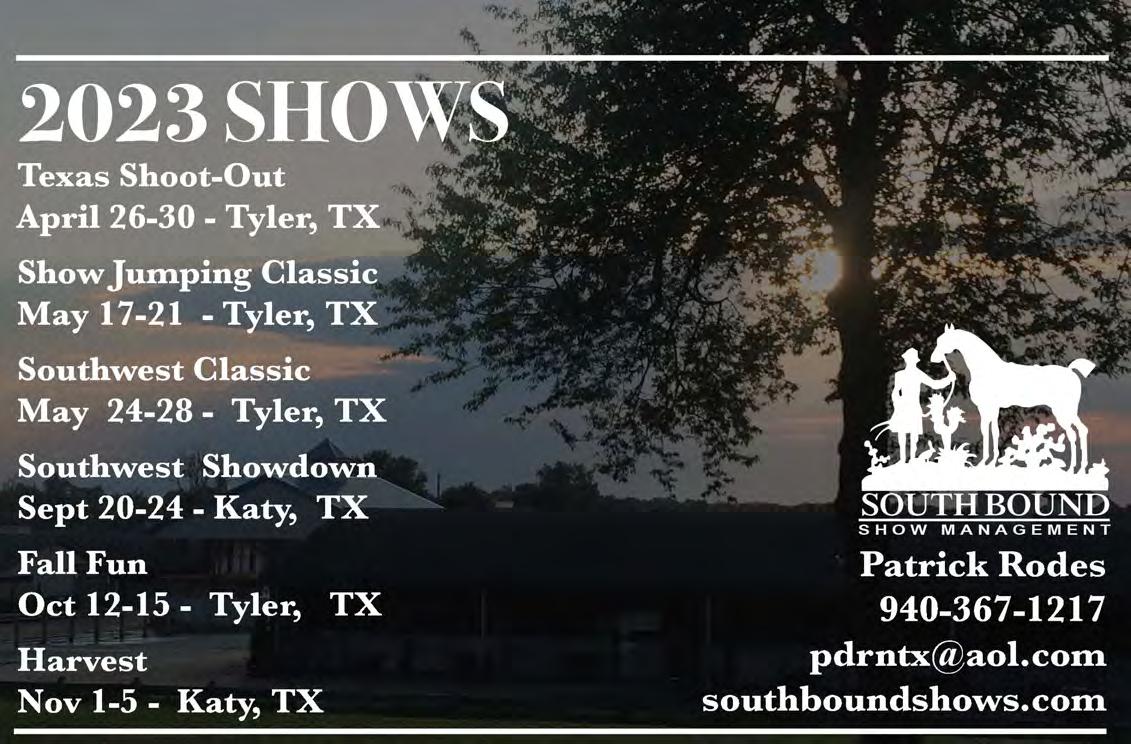
38 www.EliteEquestrianMagazine.com



www.EliteEquestrianMagazine.com 39
HIS HERS &
Eight Seconds & More with Rodeo’s Hall of Famer
L.A. Sokolowski, equinista
Ty Murray: with
John Branch, who wrote ‘The Last Cowboys,’ likened saddle bronc riding to an “eight-second car accident” but that never stopped rodeo from revving through the veins of this 10x (Arizona Sports, Bull Riding, Cheyenne Fron�er Days, California Rodeo Salinas, Na�onal Cowboy and Western Heritage Museum, New Mexico Sports, ProRodeo, Texas Cowboy, Texas Rodeo, Texas Sports)
Halls of Fame inductee and namesake of the Ty Murray Top Hand Award inaugurated by the Professional Bull Riders (PBR) Associa�on in 2018. Young Ty told his third grade teacher he wanted to beat [NFR All Around Cowboy] Larry Mahan’s record, and even a first broken jaw at age nine, courtesy of his second bull ride, didn’t deter him. Today Ty is se�led deep in the saddle of his fi�h decade, a champion cowboy with nothing to prove, a tender and devoted husband and father, and a horseman s�ll willing to grow and evolve in his rela�onship with his animals. In September, he joins Buck Brannaman as keynote speakers at the Natural Horsemanship Revolu�on in Dillon, Montana. Lucky us, we get eight seconds (and more) with him now.
HERS: What do you remember about your first horse or pony?
HIS: My dad started colts, and wound up with an Appaloosa, named Doc. He was a great kids’ horse, and did all the rodeo and gymkhana events. When I was two years old, I was running barrels on him, and he wouldn’t let me go the wrong way.

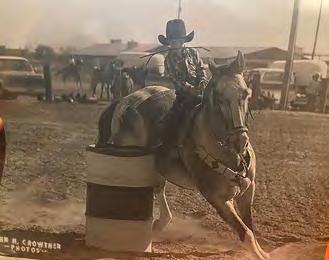

HERS: What do you like best in a horse?
HIS: At this point in life, what I appreciate in a horse is their personality, temperament, and bravery. With good horsemanship you can help a horse be a better performer but you can’t change their personality.
HERS: What do you like best in a person?
HIS: Integrity matters. Then, you need trust and respect. But if you don’t have the first, you’re probably not going to get the other two.
HERS: What was your first job?
HIS: Halter breaking racehorse colts.
HERS: If you worked outside the horse world what would you be doing?

HIS: That’s tough. I can’t imagine my life without horses. Everything I’ve ever done has been linked to them.
HERS: Favorite quote?
HIS: I have a lot of quotes, depending on the situation. If we’re talking horses, I like, “The horse will tell you what he understands and doesn’t. The problem arises when the human either does not see this, ignores it, or worse, doesn’t care.”
HERS: Who inspired and/or mentored you?
HIS: Obviously, my dad. He has a lot of grace (and can still ride a horse with no bridle). The whole of my childhood he was there, breaking racehorse colts, and at 81, he’s there to this day. He went on this better horsemanship journey with me. I still get inspired by people today – it’s important to stay in that frame of mind. Passion is the key to life and it feels good to get good at something you’re passionate about.
HERS: What makes you happy?
HIS: My family! Having my wife and kids, and my parents, on this ranch. I feel very fortunate. I’ve reached all my benchmarks. Now I have a ranch to enjoy, with them around me.
HERS: How has pro rodeo changed since you started?
HIS: The competitive opportunities have gotten better. It’s more skill, not luck. Increased popularity in rough stock events is leading to better stock. Sponsorship is a direct barometer of the popularity of the sport. Rodeo still comes down to who wants it the most – that goes right back to having the passion.
40 www.EliteEquestrianMagazine.com EQUINE Lifestyle
Ty and his daughter, Oakley, on his Clydedale, Rosie.
Ty as a young barrel racer on Doc.
Ty and Doc.
HERS: Has natural horsemanship changed how you approach handling horses?
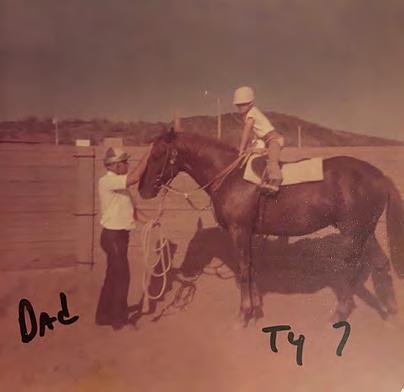



HIS: Natural horsemanship has changed my life 180 degrees and I hope it can start to do that for the rodeo world. The old way was hate me more, trust me less. Where knowledge ends is where brutality begins. Now we deal with fight or flight. A horse will be afraid or unsure. You can’t use repetitive trick training to desensitize them. When you get them soft and looking at you as leader, that’s success. Natural horsemanship is just better horsemanship. It isn’t another discipline. It’s all the disciplines.


HERS: You can invite 3 guests (past or present, real or fictional) for dinner, so who joins you and what do you eat?
HIS: That’s easy. My wife, Paige, and the kids, and we have Mexican food.
Have a His & Hers suggestion for our award-winning equinista?
Send it to latheequinista@gmail.com

EE
Ty and his son, Kase.
Ty on a colt his dad Butch was starting.
WE
Ty playing jockey.
S pectacular Fashion Fall SHOW SEASON
Our selection of quarter zip and show shirts keep you looking great in or out of the saddle!
For This
Espoir Equestrian offers equestrian lifestyle and competition clothing for the discerning rider and equine enthusiast.


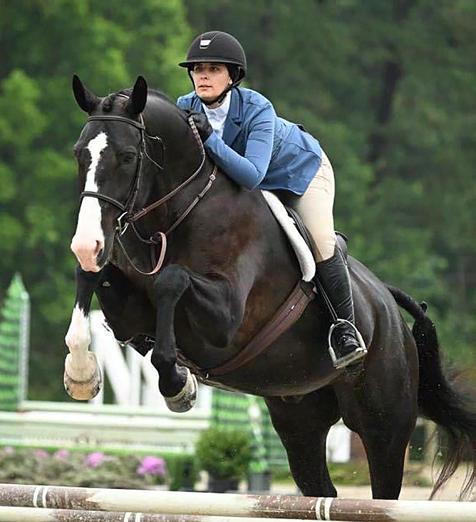


Our fall Collection includes a beautiful new Shadbelly in super soft lightweight coolmax fabric. Ladies’ sizes xs-xxl in Navy or Black with reversible points in gold or grey. $500.
Our Inspire Lightweight Show Coat offers the most comfortable stylish fit. Show here in Mid Blue!

Accessorize with color! Our new Espoir scarves come in 36” x 36” or 24” x 36” In 8 colorways.
Please visit our website to find a dealer near you!
www.espoirequestrian.com

EQUINE Fashion
EE




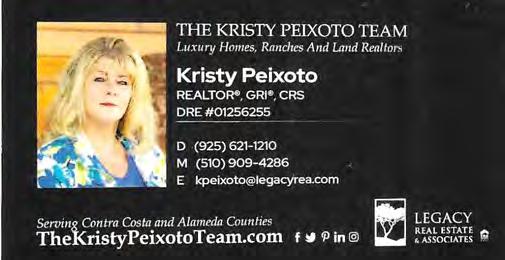
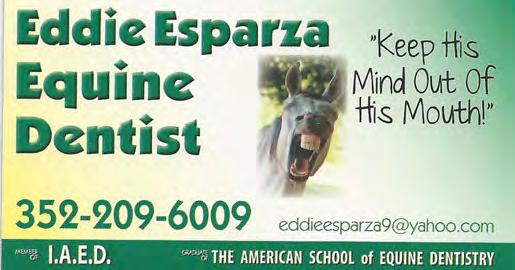


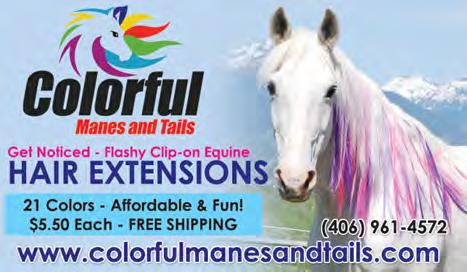
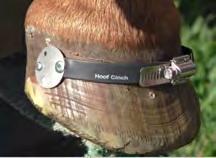

Cell Defender All natural, non-toxic formula that helps remove heavy metals and toxins. The perfect solution for pet owners looking to keep their furry friends healthy and happy Founder? Founder? �������� ���������� ������ • Stops the pain quickly • Painless application • Realigns the hoof wall to the coffin bone • Works with or without shoeing • Easy to apply 855-44CINCH www.hoofcinch.com
���������������������������������������
Story and Photos By Bill Ormstrom
What Benefits Does My Horse Get from Being Well Adjusted?
Improved Natural Defense System. Every adjustment provides a boost to your horse’s Immune System. Studies have shown that well -adjusted pa�ents have as many as 4 �mes the number of circula�ng cells that help fight disease.

Nervous System Op�miza�on. The nervous system controls every func�on in your horse’s body and the goal of the chiroprac�c adjustment is to detect and remove any impingements to op�mal func�oning of communica�on between the brain and the rest of the body. Realiza�on of Full Biomechanical Poten�al. Movement of your horse’s spine begins at the base of the skull. If this joint is not moving properly, it blocks proper mo�on in other joints of the spine, especially in the neck. Without proper mo�on of the spine, your horse is unable to express its full athle�c poten�al, even it that is just walking around the pasture.
Posi�ve Brain Changes Experienced. The chiroprac�c adjustment improves the brains’ ability to handle ac�vi�es that are occurring in the background or subconscious of the horse’s brain. This includes func�ons like breathing, diges�on and just the ability to interact with gravity in an appropriate manner.
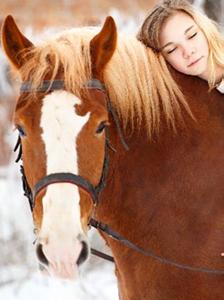
What Happens when My Horse is Out of Alignment?
Altered Body Func�on. Any �me movement is reduced, the body automa�cally goes into protec�ve lock-down measures to prevent further injury. These include swelling, heat, loss of func�on, redness, and pain. Research studies have shown that the weight of a feather on a nerve root may cause 40% loss of func�on within a few minutes. Unbalanced Nervous System Ac�vity. The autonomic nervous system that oversees priori�zing func�ons of the body gets unbalanced. The fight and flight side gets excited and doesn’t allow the rest and relaxa�on side to do its job. This makes learning and reac�ng to the environment difficult.
Muscle Asymmetry Develops. One normal step for your horse requires that every muscle and joint move correctly. This movement requires balanced symmetrical muscles. Muscle loss occurs when the muscle isn’t being used or the muscle loses proper innerva�on. Being out of alignment causes a decrease in innerva�on which leads to lack of use.

Timely Rechecks Are Important for Health and Well Being.
Realizing everything that happens when your horse gets analyzed for vertebral subluxa�ons will help you understand the need for rechecks. Vertebral subluxa�ons are vertebra that are not moving correctly and causing interference in the nervous system. The frequency of visits will depend on a variety of things that include the goals you have for your horse. High performance or just a high quality of life. Subluxa�ons can be caused by traumas (small or large), thoughts (what’s stressful for your horse) and toxins in the environment. Exercises and other modali�es will help, however once subluxa�ons are present the only way to remove them is via a very specific adjustment.
How can I tell if my horse needs an adjustment?
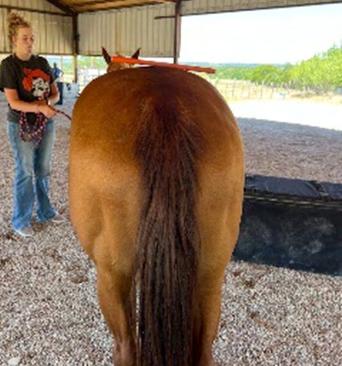
Use a neck stretch. Check for bilateral symmetry and the ability of your horse to bend the side of its face to its rib cage. Encourage your horse to extend its neck and to flex to the chest for a treat.
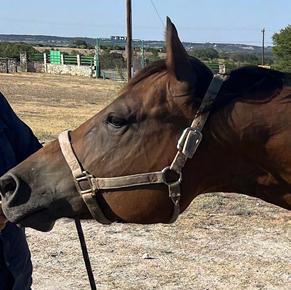
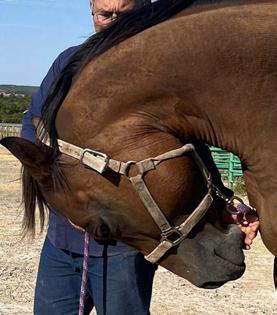
This is good flexion and extension and indicates that the top of the spinal column is moving correctly
Butt tucks are a reflex action that require appropriate communication and proper joint movement from approximately the middle of the back through to the coxofemoral joint.
Look at the top of the hip bones, they should be level and shouldn’t move when you move your horses head from side to side.
Any problems with these movements warrant a visit with chiropractor to improve health and vitality.
www.EliteEquestrianMagazine.com EE
EQUINE Health
Poor lateral flexion in the picture on the left shows that the first vertebra is out of alignment. The first movement should look like the photo on the right.
NECK STRETCH
ART ANTIQUES& By
Dr. Lori

Two Types
Part 1 Jadeite of Jade:
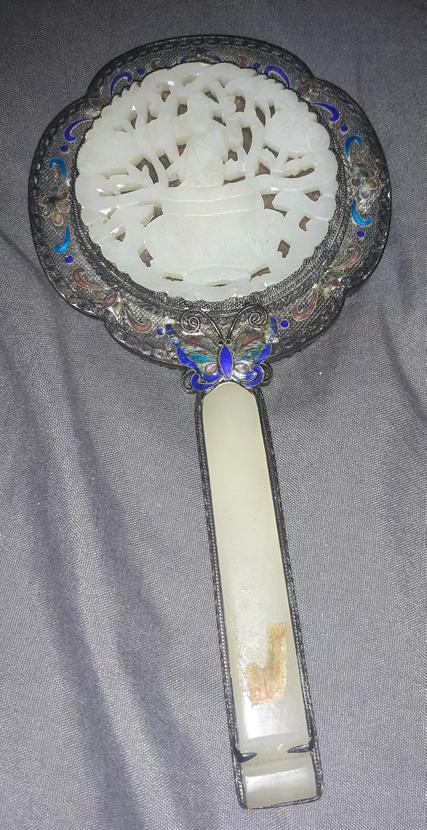 By Dr. Lori Verderame
By Dr. Lori Verderame
Jade has been a longtime symbol of status in China since the ancient times. Jade is an important material and it is often used in carvings, jewelry, screens, decorations, etc. Jade is held in high regard as valuable and culturally and artistically significant too.
Jade symbolizes success and good luck and it comes in two forms. In part 1 of this column I will discuss jadeite and in part 2 of this column I will tell you about nephrite. Both beautiful and related. Jade comes in two distinct forms: jadeite and nephrite. These two forms –jadeite and nephrite-- are similar in that they are both stones that are formed by a grouping of interlocking microcrystals. Each piece of jade is one of a kind and has a definite character.
Both jadeite and nephrite are hard stones and both are called jade, however there are differences in the chemical composition. Jadeite is a silicate compound of sodium and aluminum. Nephrite is a silicate compound of calcium and magnesium.
Most jade traded today is jadeite jade. It is harder and more dense than nephrite jade. It is more expensive than nephrite jade too. Jadeite comes in many colors of green. Jadeite does not have layers the are visible.
Jade has many imitators. Many stones look like jade but are not real jade. For instance, Aventurine, a type of quartz, is a green stone that is also known as Indian jade or Australian jade. Greenstone is a green stone and it is a jade look alike too. Serpentine is the name for many types of stones and they all resemble jade. Serpentine is waxy, green stone which is not as smooth as jade but sometimes is mistaken for jade. Chrysoprase imitates jade’s two forms also. Jade can be mistaken for green quartz or prehnite and vice versa. These various jade look alike stones are good-looking stones but are not as beautiful or valuable as jade.
Fake jades can be susceptible to chemical bleaching, color dying, and doubling, also known as layering. Some fake jade items are treated to look more translucent. Some fake jade items are treated to accept a plastic coating to enhance the object’s look. Natural, authentic, real and untreated jade is usually only treated with a plum juice wash or beeswax polish as it then will retain its true and natural color.
Jade is the stone that is used in special jewelry pieces such as the Bi symbol disc pendants that represent the Chinese symbol for eternity. The Bi symbol has a great spiritual significance. The Bi symbol is often presented carved in jade. Butterflies symbolize long life and they often carved into pendants, pins, earrings, etc. made of jade. Other symbols that are important to Chinese culture which are often represented using jade include: the bat, a symbol of happiness, the dragon which shows power and prosperity, the peach which references immortality, and the circular disc with a central hole which references happiness and heaven.
www.EliteEquestrianMagazine.com EQUINE Lifestyle EE
Jade mirror, late 19th Century Photo by Staff of www.DrLoriV.com
����������������������������������������������������������������������������� ������������������������������������������������������������������������������ ��������������������������������������������������������������������� ����������������������������������������������������������������������������� ���������������
HABRONEMIASIS
and the Horse Eye

The same parasitic disease that causes summer sores, Habronemiasis, can also affect the horse eye. Although it may be described as “fly eggs” causing ocular irritation, this is a misnomer since it is a larval stage of the parasite that migrates into eyelid skin and conjunctival tissue. The presence and death of the larvae cause an immune response, which can lead to inflammation of the eyelids, third eyelid, bulbar and palpebral conjunctiva, and the nasolacrimal system. Secondary effects on the cornea can be even more serious.

Understanding the parasite, its life cycle and treatment is important in managing the infection. Habronema spp. (Habronema muscae, Habronema microstoma and Draschia megastoma) are stomach worms that adhere to the stomach wall of a horse and release eggs that pass in the feces. The normal life cycle is completed when larvae that develop from the eggs are ingested by horses and develop into adult stomach worms. Alternatively, the larvae may be ingested by an intermediate host – stable or house fly - that transports and deposits larvae onto the face. The larvae begin an aberrant migration into the tissues around the eyes and eventually die during their migration or exposure to parasiticide treatment.
Prevention of stomach worms, managing manure properly and controlling flies are important steps in minimizing summer sores and eye infections. Treatment with ivermectin and moxidectin dewormers will kill larvae and adult stomach worms. Disposing of manure in a timely and proper manner will help prevent the development of larvae in the manure. A multifaceted approach to fly control will help to decrease fly populations. Fly spray and fly masks are simple husbandry methods in compliant horses. A possible dilemma, however, is that nearby farms may also contribute to problems if Habronema spp., manure and fly populations are not properly managed.
Treatment of eye infection depends on the location and severity of the inflammation. It is important to note that if one horse on a farm is affected, then all horses on the farm have the potential for exposure and infection. The degree of inflammation can be highly variable between horses. This may reflect differences in individual immune responses and the fact that certain individuals will develop a more serious hypersensitivity reaction to the larvae. A common presentation is swelling or puffiness of the corner of the lower eyelids toward the nose, but some individuals will develop large open sores on the eyelids and hard, pebblelike granulomas. The white-yellow granulomatous lesions, mistakenly described as fly eggs, represent the immune reaction to the larvae and can be very rough and irritating. Granulomas in the palpebral conjunctiva and posterior aspect of the third eyelid can create corneal ulcers.
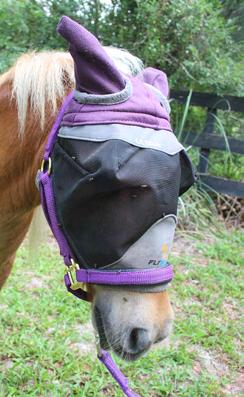
It is often beneficial to remove superficial granulomas and especially if they are causing or may cause corneal irritation. Removal of the granulomas may also decrease inflammation. Larvae developing or dying at different stages could cause new granulomas to develop even after initial removal of granulomas. If corneal ulcers are not present, topical corticosteroids are used to control inflammation and subconjunctival injections may be administered. For large eyelid lesions, intralesional corticosteroids can be very effective. Systemic anti-inflammatories, including corticosteroids or Banamine may also be used. Treatment with an ivermectin or moxidectin dewormer is also initiated and repeated in 2-4 weeks.
Deworming programs to target the stomach worms and larvae are one part of the control of ocular Habronemiasis. Management of horse manure will help reduce the populations of infective larvae. Stable and house flies are the intermediate host that result in deposition of larvae and aberrant migration into the ocular tissues. Therefore, seasonal increases in fly activity will naturally cause an increase in ocular Habronemiasis. Fly control is critical in reducing the transmission of larvae. Each case of ocular Habronemiasis will require different types of treatment depending on the severity, location, and degree of inflammation.
www.EliteEquestrianMagazine.com EE
Fly masks are essential to combat parasites and diseases they cause.
EQUINE Health
Story and Photos By Dr. Brendan G. Mangan
Fly mask and halter from www.shiresequestrian.com
Equine Asthma Syndrome:
Manage the Environment to Help Manage the Disease
Equine respiratory issues can lead to decreased performance and difficulty breathing, even when at rest. That’s why horse owners need to take a three-pronged approach to managing the disease: environmental control, use of glucocor�coids to reduce inflamma�on and if needed, administra�on of bronchodilators.
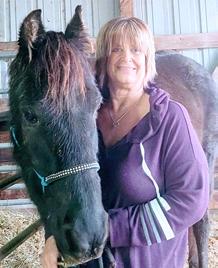
Equine asthma ranges from mild-moderate to severe. A horse suffering from severe equine asthma experiences a narrowing or obstruction in the airway passages. Most often, this narrowing manifests itself in coughing, wheezing or labored breathing even at rest. Identifying and managing equine asthma early is important because without diagnosis and treatment, the condition can have a long-term impact on the lungs.
Most equine respiratory diseases are caused or exacerbated by the inhalation of airborne dust. A horse can inhale 4.6 million dust particles in a single breath. The dust particles contain allergens and when exposed to those allergens, the airways can become inflamed.
Managing the environment is an imperative practice whether the horses living in the barn have respiratory disease or not, but it’s especially important when trying to manage severe equine asthma.

Steve Grubbs, DVM, PhD, DACVIM, Technical Services Veterinarian, Boehringer Ingelheim, provided some tips to help keep the barn environment as healthy as possible.
“Diet and bedding are the primary source of dust in the barn,” says Dr. Grubbs. “For the horse with severe equine asthma, managing those should be addressed first.
“The best solution, if the asthma is barn-induced, is to provide pasture turn-out full-time, eliminate round bales and decrease dust associated with hay,” he adds.
Where 24-hour turn-out is not available, Dr. Grubbs suggests the following:
•Keep horses in a clean, well-ventilated, low-dust environment
•Feed a cubed or pelleted diet
•Soak hay
•Avoid storing hay above stalls
•Minimize sweeping or blowing of floors while horses are in stalls
•Allow time for airborne dust to settle before returning horses to stalls
•Use low-dust bedding
IMPORTANT SAFETY INFORMATION: ASERVO EQUIHALER has not been evaluated in pregnant or lactating mares. In a large clinical field study, the most common adverse reactions reported were coughing, nasal discharge, sneezing and nasal irritation/bleeding. Not for use in humans. Keep this and all medications out of the reach of children.

“While these environmental management efforts won’t always eliminate respiratory issues, they can help minimize the impact,” says Dr. Grubbs. For more information about severe equine asthma syndrome, visit bi-animalhealth.com.

“I feel like the ASERVO EQUIHALER gave him his life back. Truly, he was probably a few hours away from being euthanized when I saw this product, so I feel like the ASERVO EQUIHALER definitely caused him to feel much be�er and has given him some quality of life.”
What were Memphis Slim’s symptoms?
His main symptom was severe dyspnea, and he did have some bilateral frothy nasal discharge when his symptoms were at their worst.
How has the Equihaler helped him long-term?
The EquiHaler has definitely helped him long term. His respiratory effort is minimal on most days, and he no longer has any nasal discharge. I have been able to reduce his dose to alternate days for the most part, especially in dry weather.
Learn more about Boehringer Ingelheim Animal Health USA at bi-animalhealth.com.
www.EliteEquestrianMagazine.com EE
EQUINE Health Elite Equestrian does not endorse or confirm content suggestions in any articles. See credit page for disclaimer.
SHAUNA ROBERTS, DVM Polo Animal Hospital, Polo, Illinois with Memphis Slim, Rescue.

www.EliteEquestrianMagazine.com 15

Natural Balance:
Lope, English Trot, Jog
Palm Partnership Training™
Building a Partnership with your Horse
by Lynn Palm
What is Natural Balance?
Natural Balance is when your horse attains proper self-carriage according to his conformation. When the horse is balanced, the horse is straight. Straight means that the hind legs track on top of the footprints of the front steps, whether on a straight line or a curving line. When a horse is in Natural Balance and self-carriage, his movements will be relaxed and fluid. When a horse is strong and has a correct Natural Balance, he will be fit, has had play time, and is willing to do what you ask.
Natural Balance is the first foundation training that I want to get solid with my young horse, before I go on to more advanced training. I will spend considerable time for the horse to develop his Natural Balance. When I take that time, I am building the best solid foundation on my horse that he can achieve, and one that will last forever.
What do I look for? For true Natural Balance, I first want to see if the horse has Natural Balance at liberty with NO line or lead attachments. At each gait of walk, trot and canter, I study the horse’s self-carriage; that tells me what I want to achieve under saddle. I next want to observe the gaits by longeing the horse on circles of different sizes, and on a straight line. Does the horse keep himself relaxed? Does his movement get more defined with a steady tempo? What I see with my eyes, I want to achieve under saddle. This early training may take a year or more, depending on the horse. I wait to get this balance in all three gaits, especially the canter or lope, which takes the longest to achieve.
Natural Balance allows your horse to be balanced, move correctly, and be willing in performance.
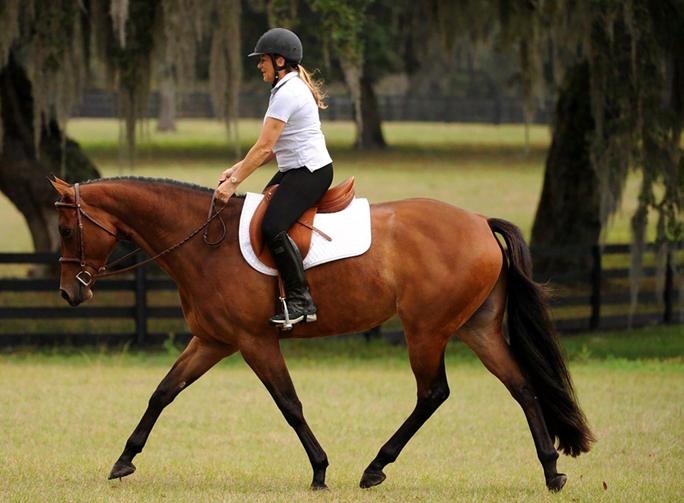
What is Working Trot?
English Trot should be a “Working Trot”. This means a trot that has energy and is really covering ground. The trot should not be slow or sluggish. A trot that covers ground is what you want in a Hunter in order to have powerful strides for jumping. It is required for the horse to be in a Working Trot in all Dressage levels from Intro, Training, and First Level. The trot is active, the rider is in charge of the pace, and the horse is truly covering ground. This trot will get the highest marks in Dressage and is necessary for the horse to be “in gear” for any work over fences.
What is Jog?
Jog is a Western term for trot. The jog is a slower gait, with two definite beats to one stride. The jog is a relaxed, smooth trot, and can cover ground with smaller strides than an English trot. The jog is best known in Western Pleasure, What is Lope?
Lope is a Western term for the canter. It should have a definite three-beat to each stride. The horse should be relaxed in his overall look, especially in the neck. A horse that has a tight neck will have a tight back, thus shortening the engagement of the horse’s hind legs for energy or balance. The horse’s poll should always be level with or above the wither or top line; this helps with correct balance and to create three-beat strides. For the horse to be naturally balanced, he should display the same strides at liberty (on his own) as with the saddled rider.
Horsemanship, Trail, and Western Riding. The jog gait should be smooth and comfortable to ride. The jog should be ridden in a correct balance, with the horse’s poll level with or above the wither or top line.
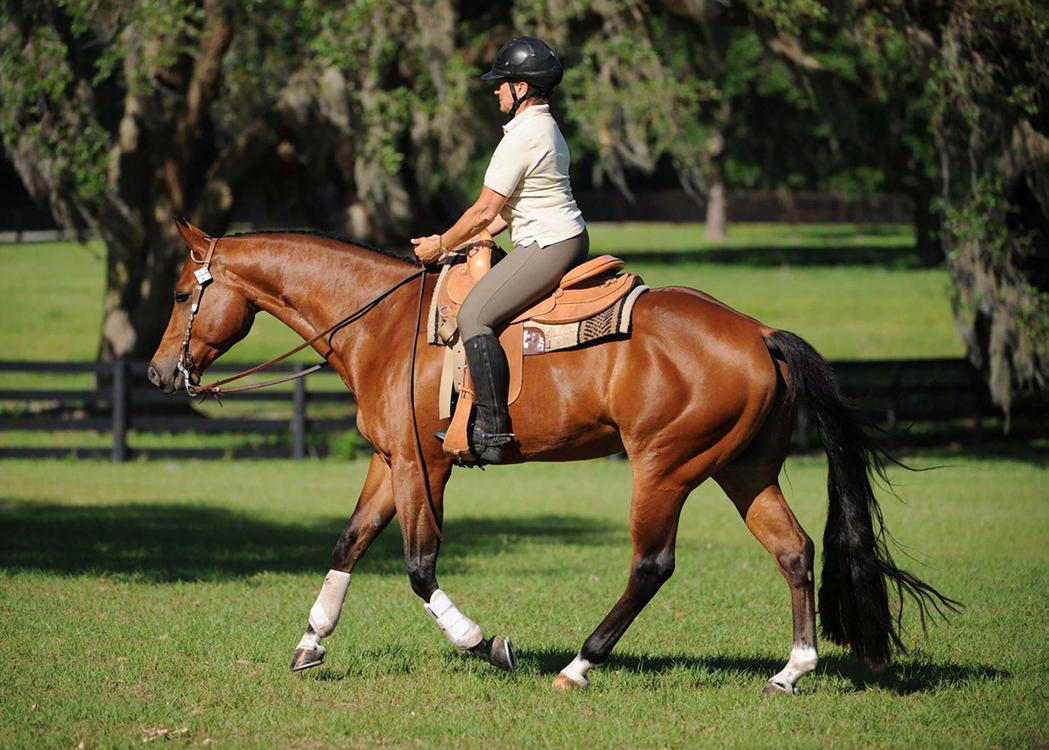
Understanding Natural Balance May Save a Horse.
Natural Balance, or Natural Self Carriage is something all horse owners should understand, especially with Western Riders/horses. Natural Balance allows your horse to be
www.EliteEquestrianMagazine.com
TRAINING & Showing
balanced, move correctly, and be willing in performance. Especially in the Western world, this is not appreciated and understood enough. Horses are being destroyed and disposed of because they are not staying sound in the mind or body, and they just don’t like the show ring anymore….. why? What you may be doing with your horse is not in the horse’s best interest. They will challenge you, they will break down mentally or physically and be a short-term horse, if not allowed to learn Natural Balance/ Self Carriage and encouraged to move correctly.
I will always strive for longevity for my horses whether I own them or not. The horse always comes first. Remember, horses only want to graze all day and night long. They don’t care about our goals in any way. Horses will participate with our goals if we understand them, treat them with respect, and always care about the horse’s wellness first. This is why I love to share my knowledge. Horses are magical. If you don’t know that, search for it! Start recognizing their language! They are always there for us, if we just understand them!
Palm Equestrian Academy


generalinfo@lynnpalm.com
352-362-7847
Cyril and Lynn offer clinics throughout the country and abroad as well as online coaching. Join them on their teaching tours or their Palm Equestrian Academy European Journeys.
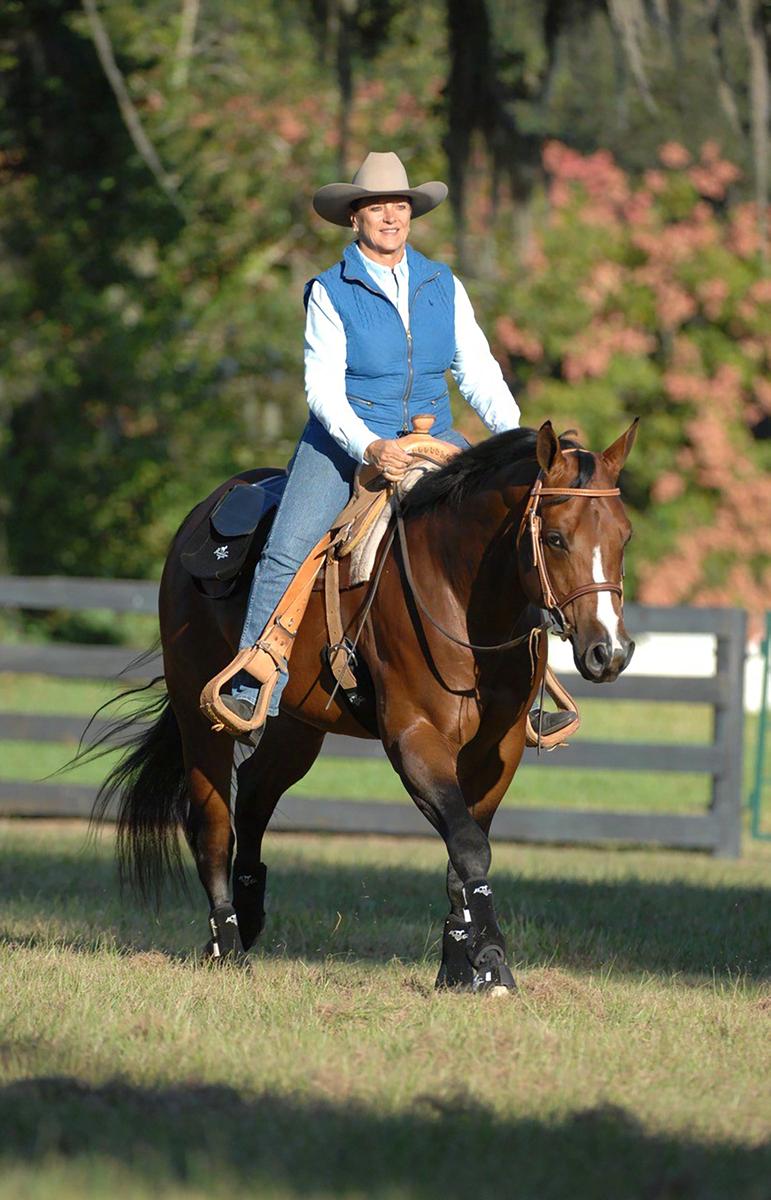
EE
www.EliteEquestrianMagazine.com
I will always strive for longevity for my horses. The horse always comes first.
& Showing
EQUINE EMERGENCIES

On The Road
Story and Photos By Neva Scheve
Most people don’t want to think about it, but things happen when you are hauling horses. If you are new to trailering, you may be nervous about transporting your horse and feel unprepared for an accident or a sick horse while you are on the road. The more knowledge and experience you acquire, the more you will be prepared to handle those emergencies. Or you may be that person who says, “I’ve been hauling for years, and never had a problem.” If so, you may be overdue.
The potential for en route emergencies, even on short trips, is real, and if one adds the stress of human injury to the situation, common sense suggests that forethought may be critical.
Each time a horse is put into a trailer, he is at risk. He may receive minor bumps and bruises just from being loaded in the trailer, He may injure himself during the trip because he becomes frightened or loses balance. Illness or a trailer accident can create a life-threatening situation.
Smart pre-trip preparation can reduce the chance of serious consequences.
A well-trained horse is less likely to injure himself or suffer from stress. A safe trailer can make a minor incident out of a serious situation. The safer trailers will have interior dividers, butt and breast bars that can be removed quickly, and an exit door to get the horse out quickly. Quick-release trailer ties will make it easy to remove a horse from the trailer. You don’t want the horse to be able to break a halter or lead and get free from the trailer and run out on the road. If you absolutely must use a breakaway halter, put a second halter on the horse with a short lead so once you release the horse, you will still have something to hold on to him. Never get inside the trailer with a panicked horse. Use a proper hitch and tow vehicle.
Wrap all four legs with good shipping boots or bandages. A head bumper is never a bad idea.
Ventilation is crucial. To avoid shipping fever the horse should have enough headroom to be able to lower his head to cough out contaminants in the air from hay and shavings.
Carry an emergency first aid kit. One for the horses and one for humans. And learn how to use them. The kit should include a splint.
Learn how to monitor vital signs in the horse. Ask your vet to teach you to check for dehydration and overheating, stop bleeding, and use that splint if you ever need to do it. Know normal heart rate and GI motility sounds. Only carry tranquilizers if you know how and when to use them.
PINCH
RETURNS TO NORMAL HYDRATION LEVELS
O -2 SECONDS HYDRATED
2-4 SECONDSMODERATE DEHYDRATION
4+ SECONDS SEVERELY DEHYDRATED
NORMAL VITAL SIGNS
Temperature: 99.5-101.5
Respiration: 8-16 breaths per minute
Heart Rate : 20-40 for adult horses
80-120 for new-born foals
60-80 for yearling
Skin Pinch Hydration: should return to normal position within 1-2 seconds
Capillary Refill Time: 1-2 seconds – pale, dark red, muddy, or slow refill time – needs immediate veterinary assistance
Assume that in an emergency EMTs and police will most likely not know how to help with the horses. Carry a durable visible medical ID that lists your doctor and contact person. If you are incapacitated in an accident, the EMTs/police will need to contact someone who knows you and your horses. On your phone, you can add the letter “ICE” (In Case of Emergency) to those contact people who should be called by emergency personnel.
Not all emergencies are caused by accidents. Horses can become ill on the trip, especially long ones. Dehydration is the main cause of colic and overheating. If your horse won’t drink on a long trip, you may have to schedule stops along the way where you can unload your horse in a safe place where he can drink. You may not realize your horse is sweating because the sweat can evaporate in the trailer and he won’t seem wet. Carry extra water for cooling off a horse in hot weather and for cleaning off wounds if necessary. Older horses, younger, or nervous horses may need extra care because of increased stress. Know how to look for symptoms of stress and check for vital signs along the way.
It sounds scary, but the better prepared you are, the more confident you will be to handle any situation. Plan for the worst, and hope for the best. You can do it!
www.EliteEquestrianMagazine.com
TRAINING
Elite Equestrian does not endorse or confirm content suggestions in any articles. See credit page for disclaimer.
SKIN ON NECK NEAR POINT OF SHOULDER
SKIN PINCH TEST
INSERT PINCH TEST AND CRT

































































































 By L.A. Sokolowski
By L.A. Sokolowski
























































 By Dr. Lori Verderame
By Dr. Lori Verderame














